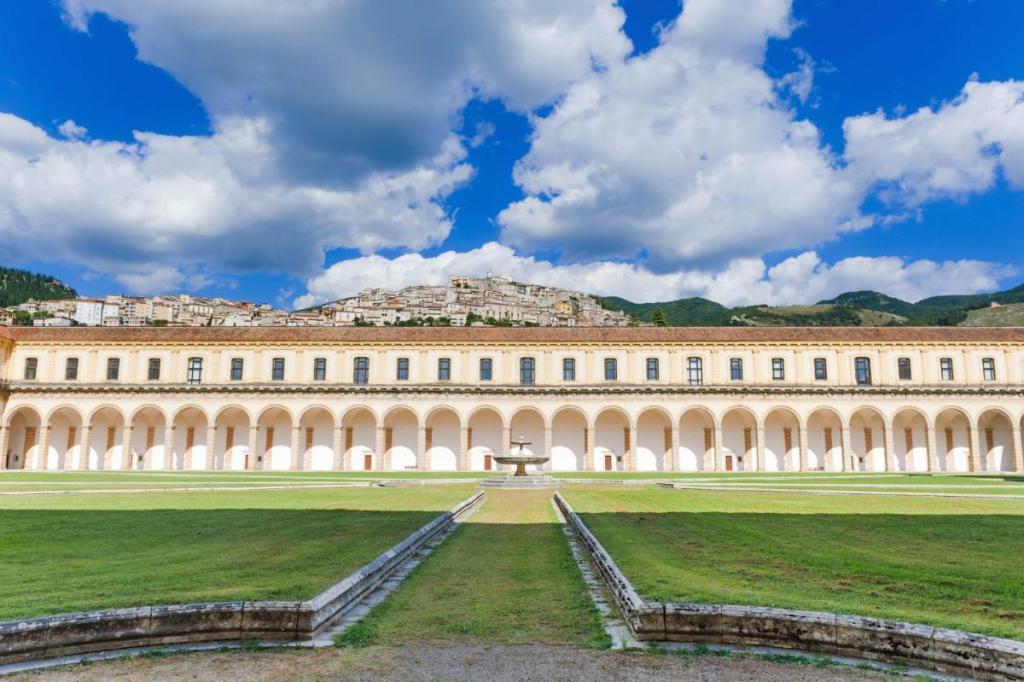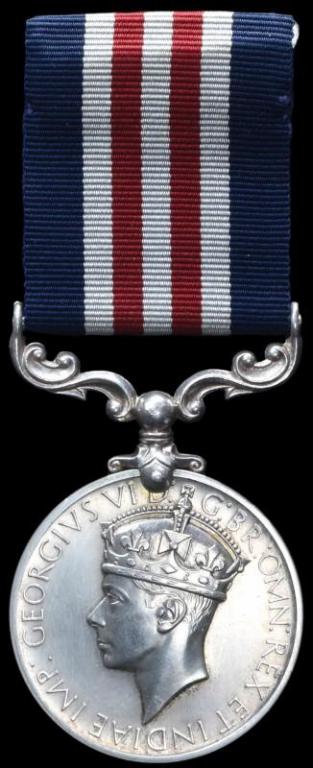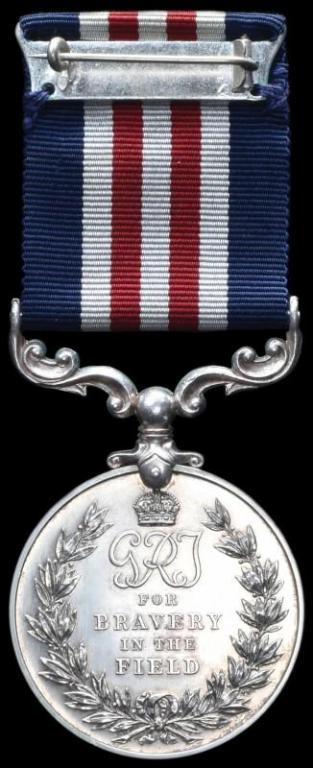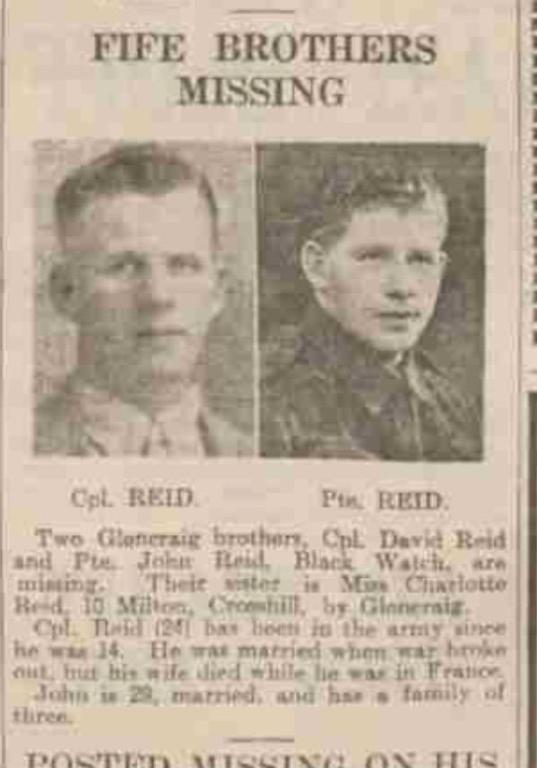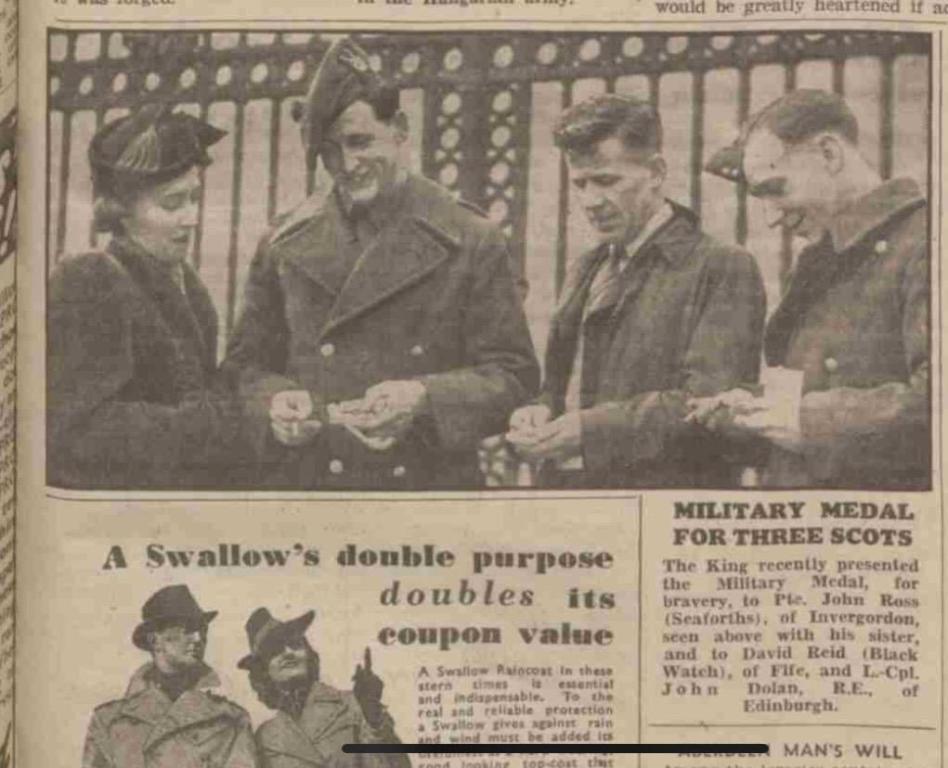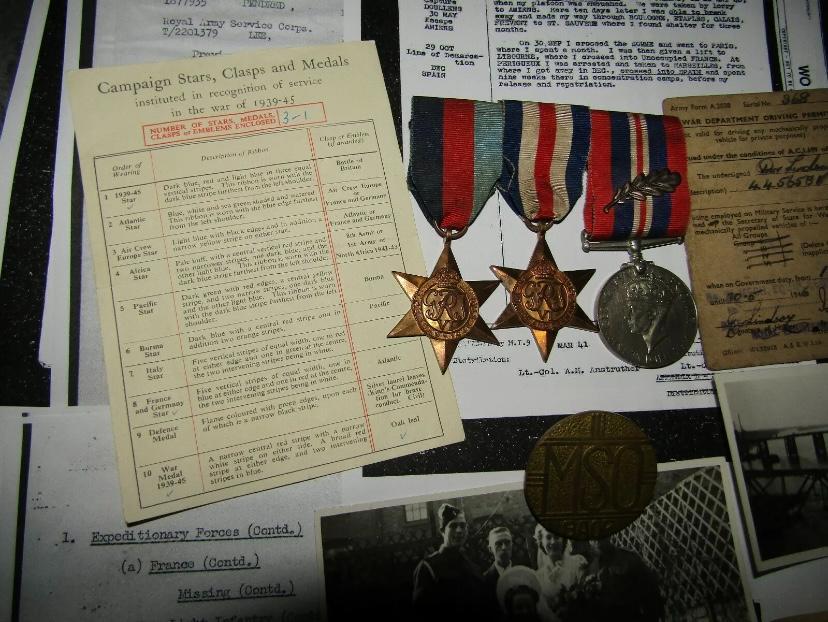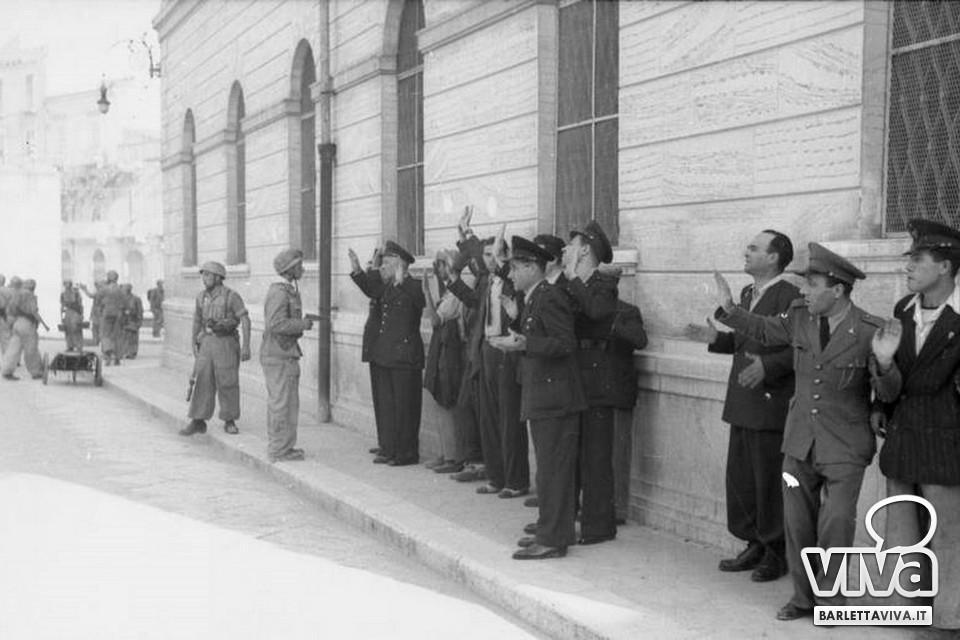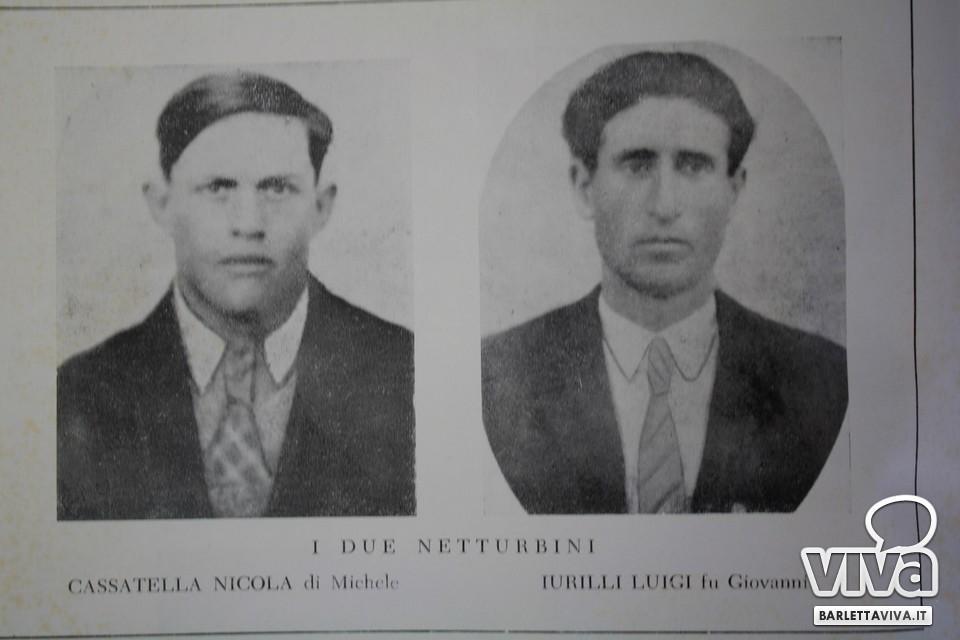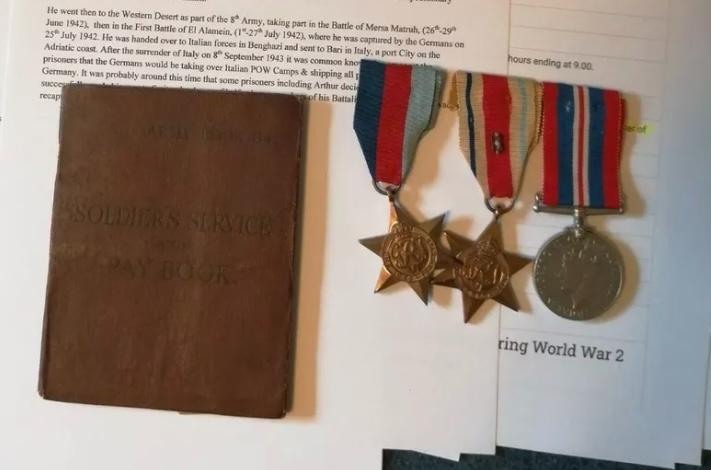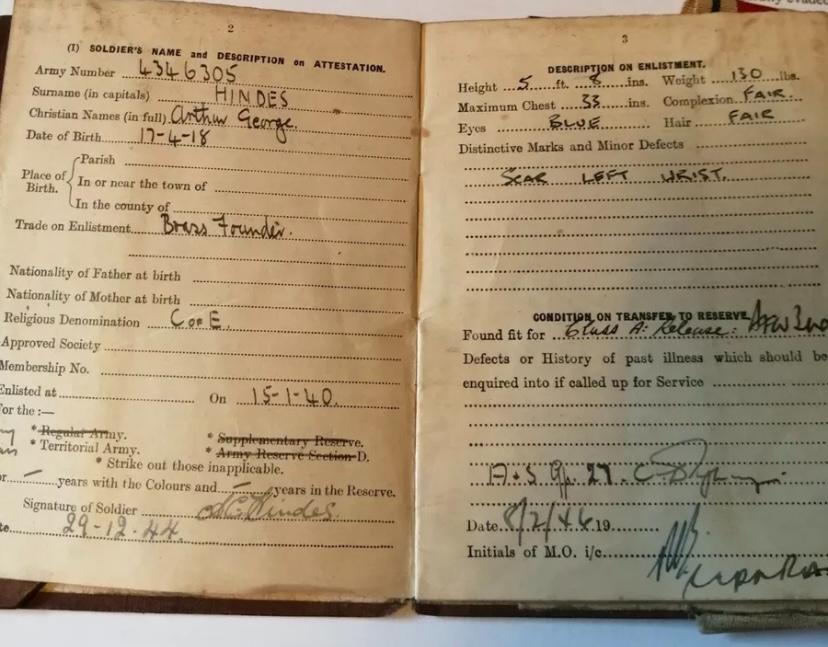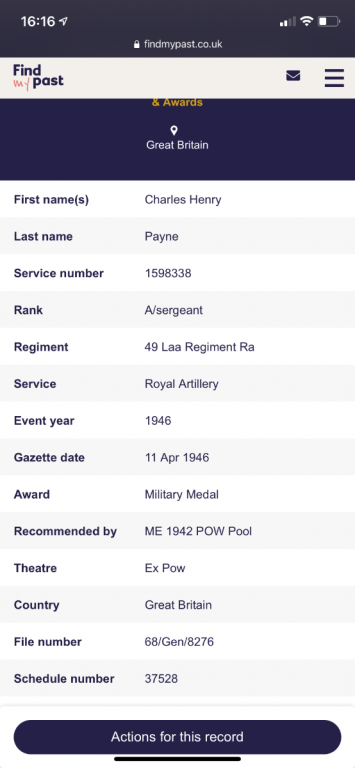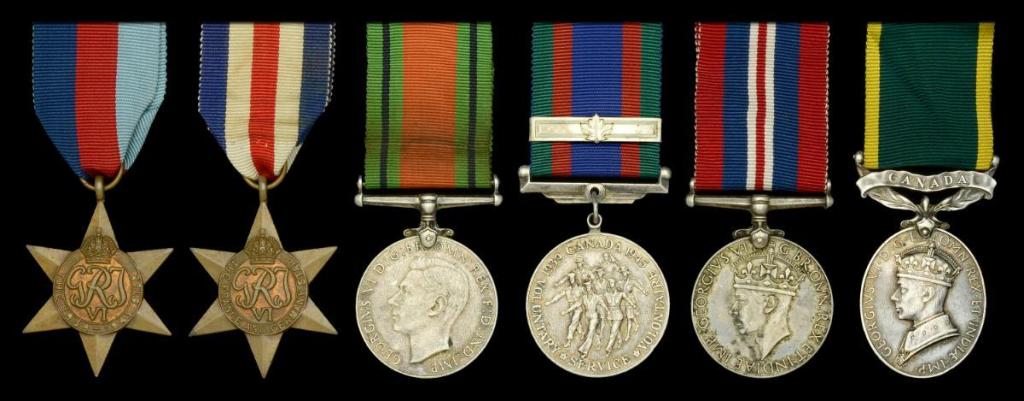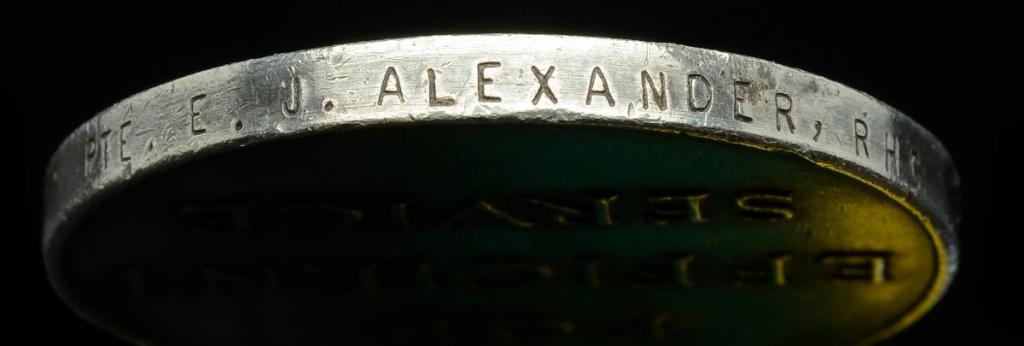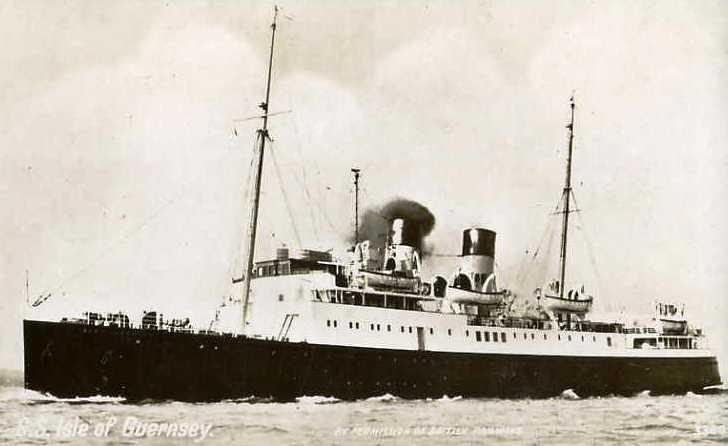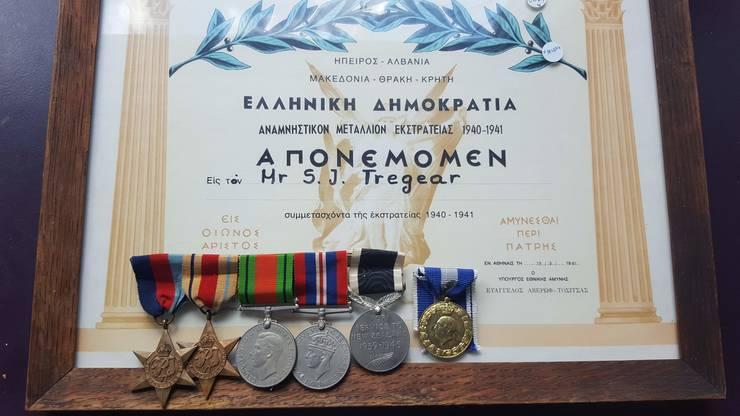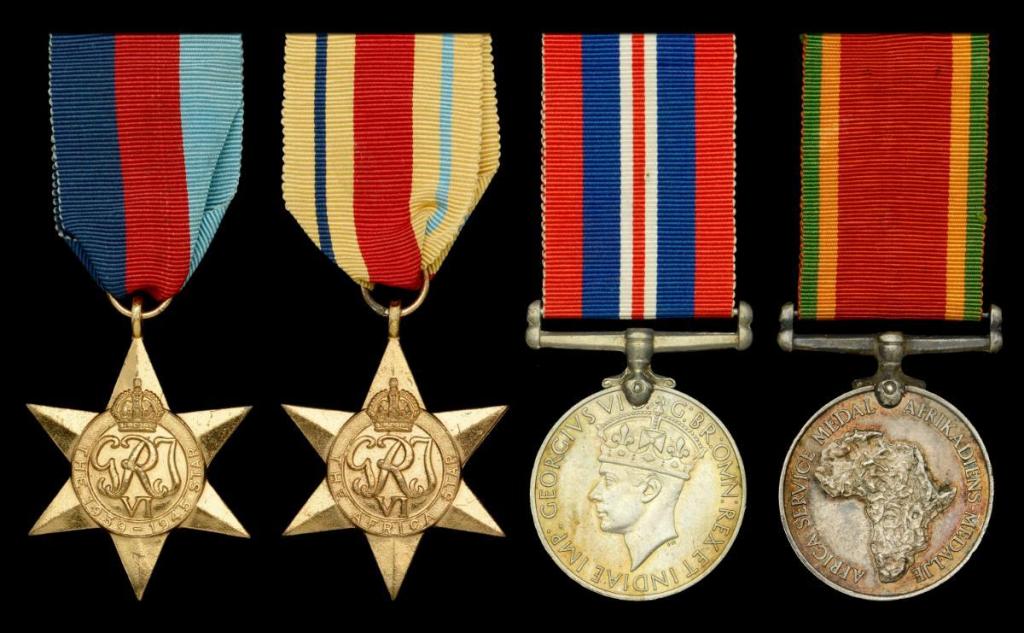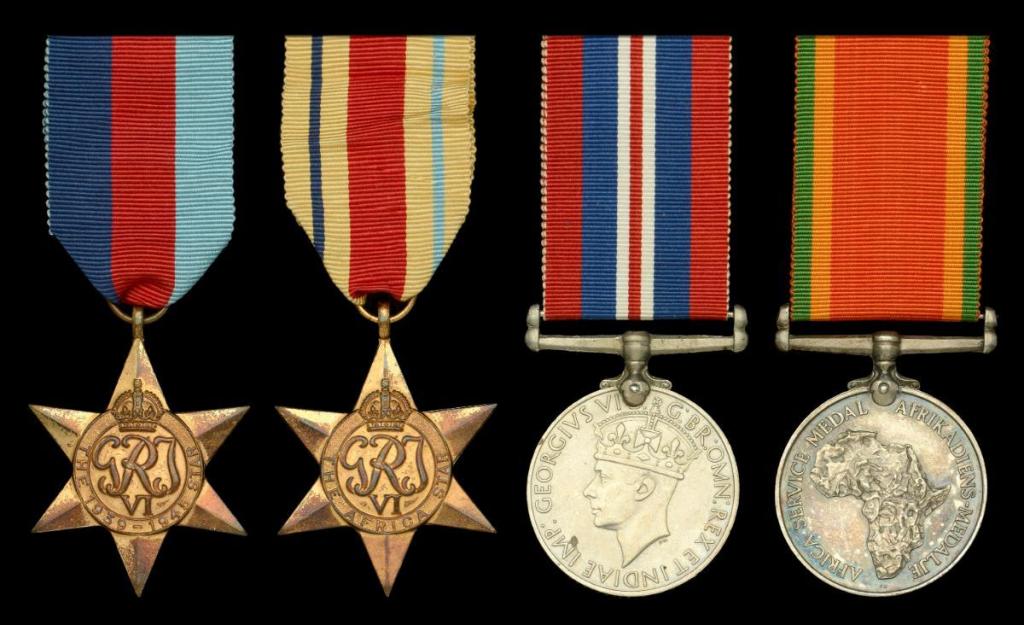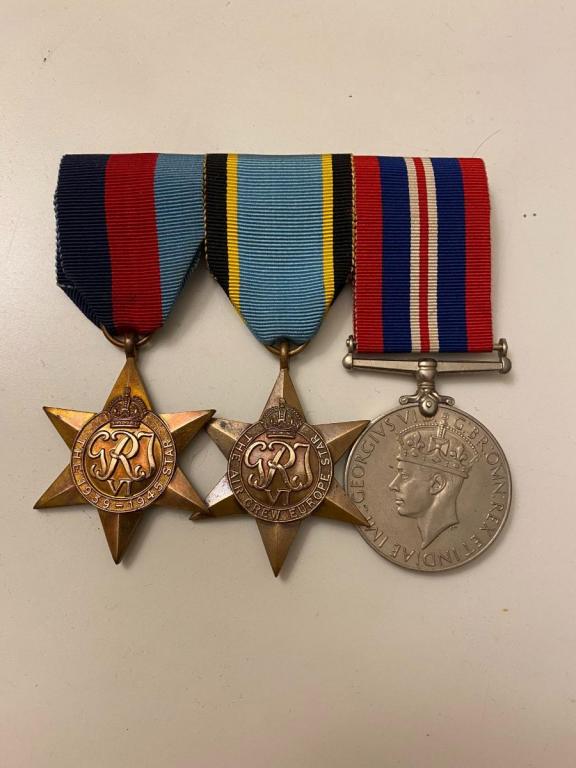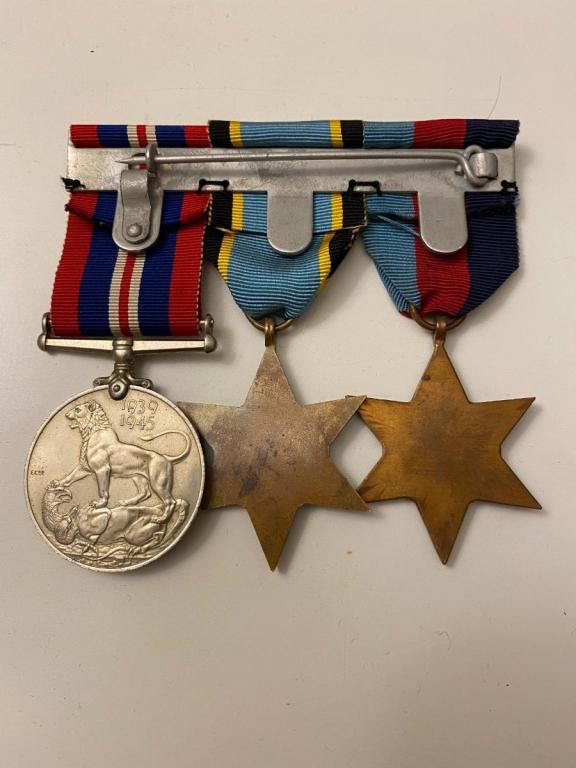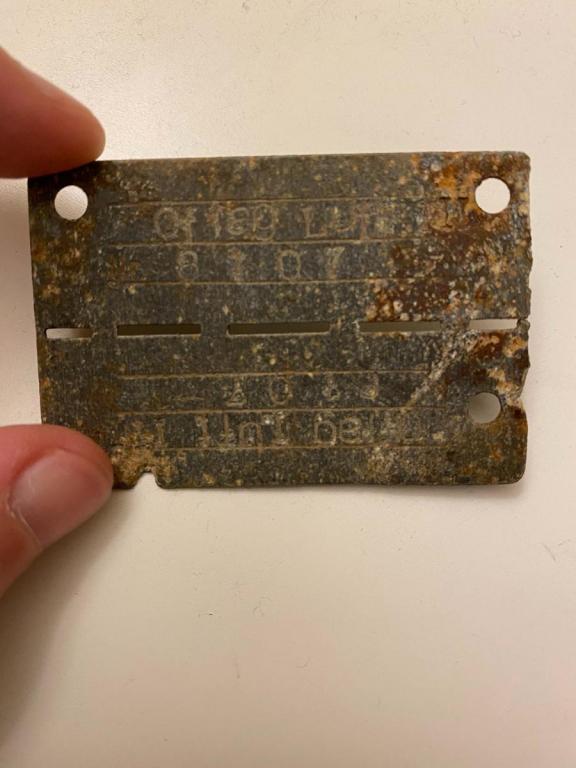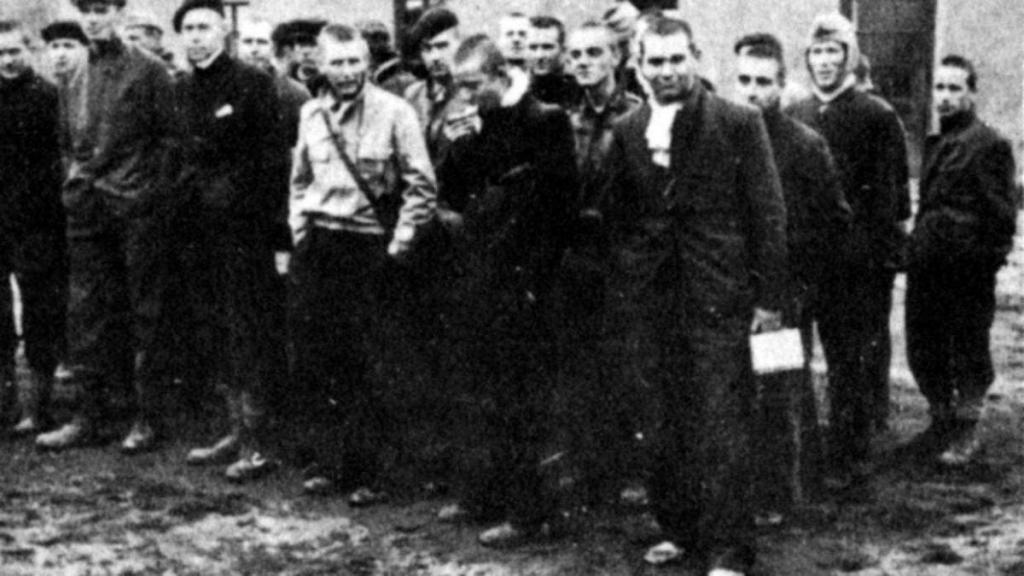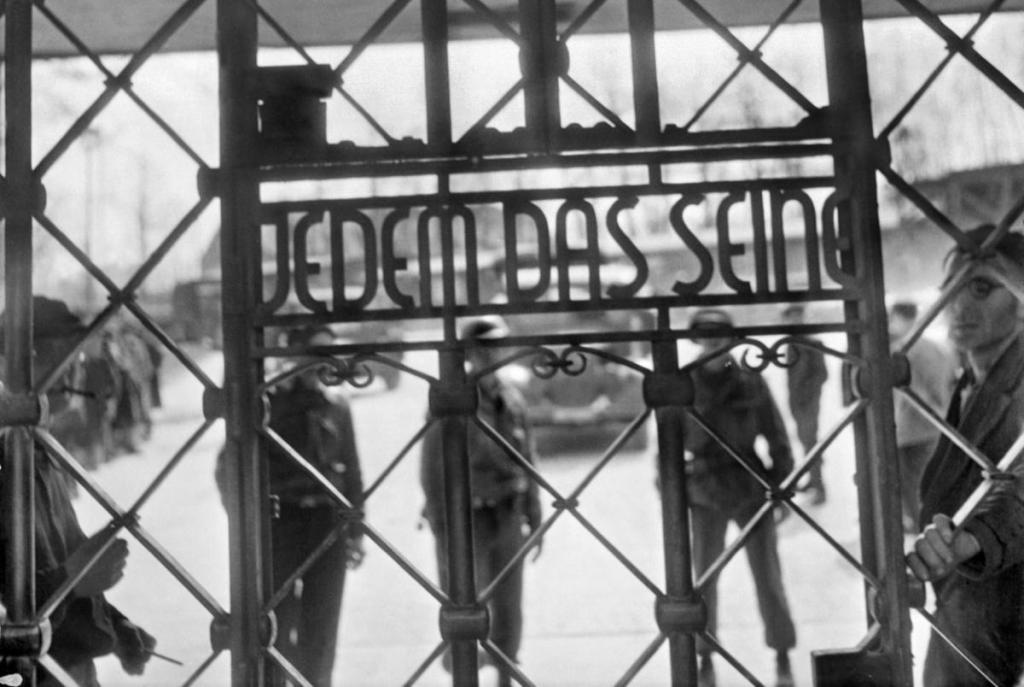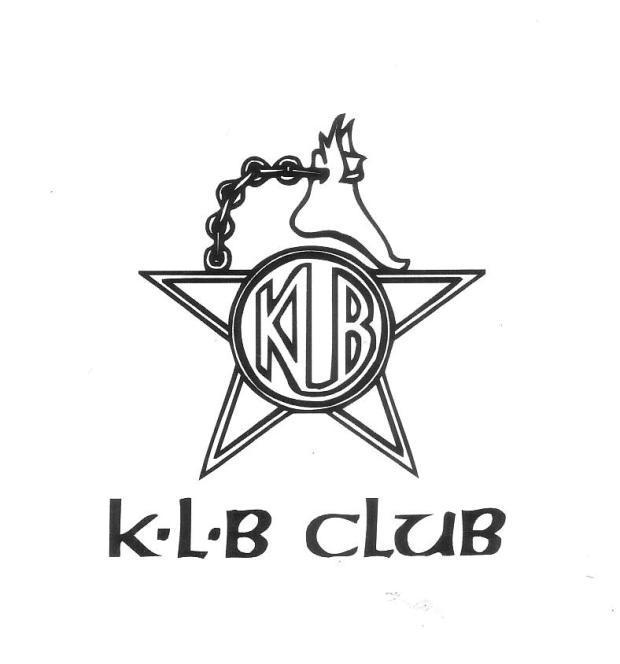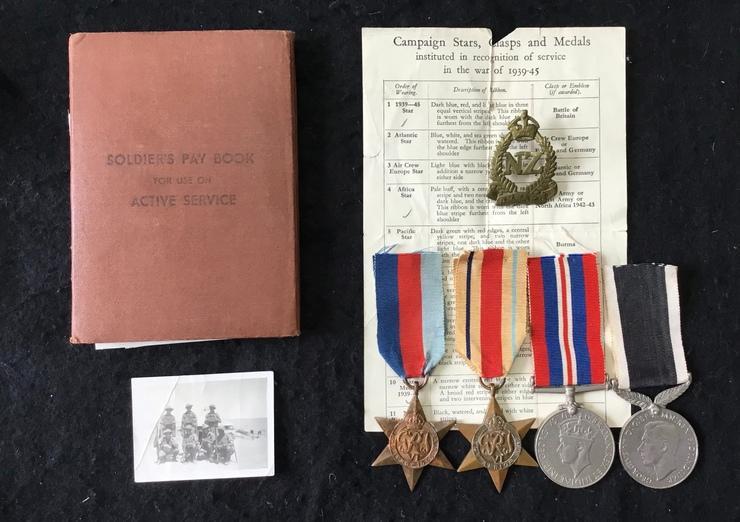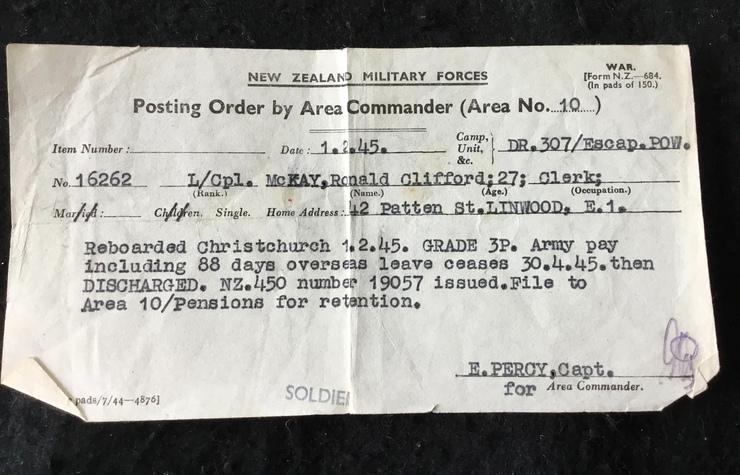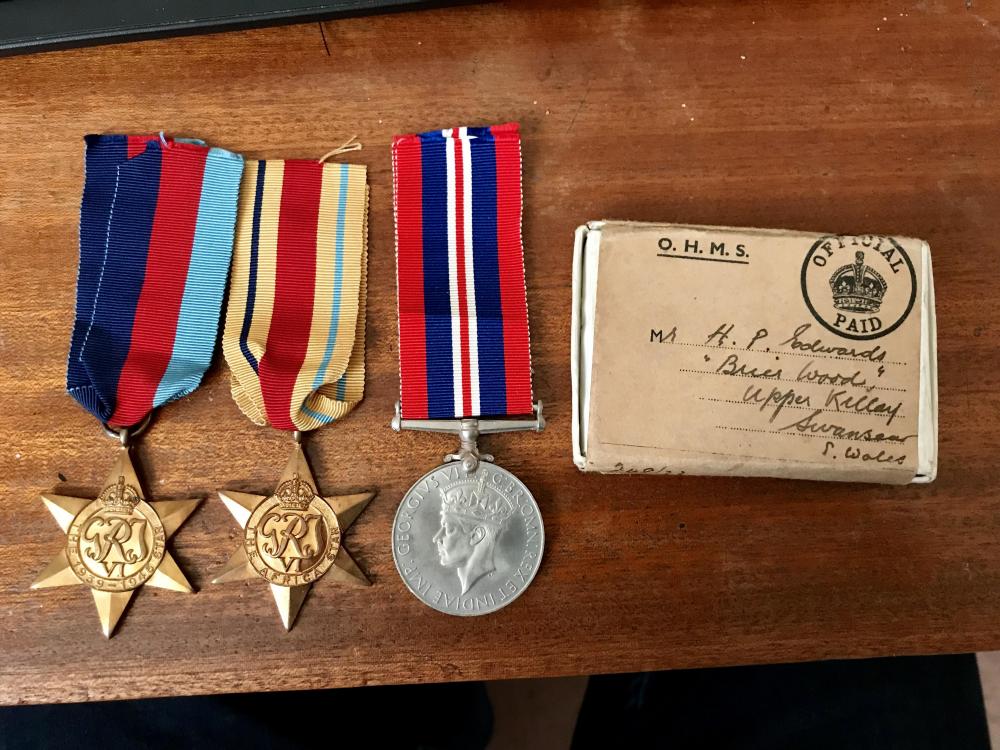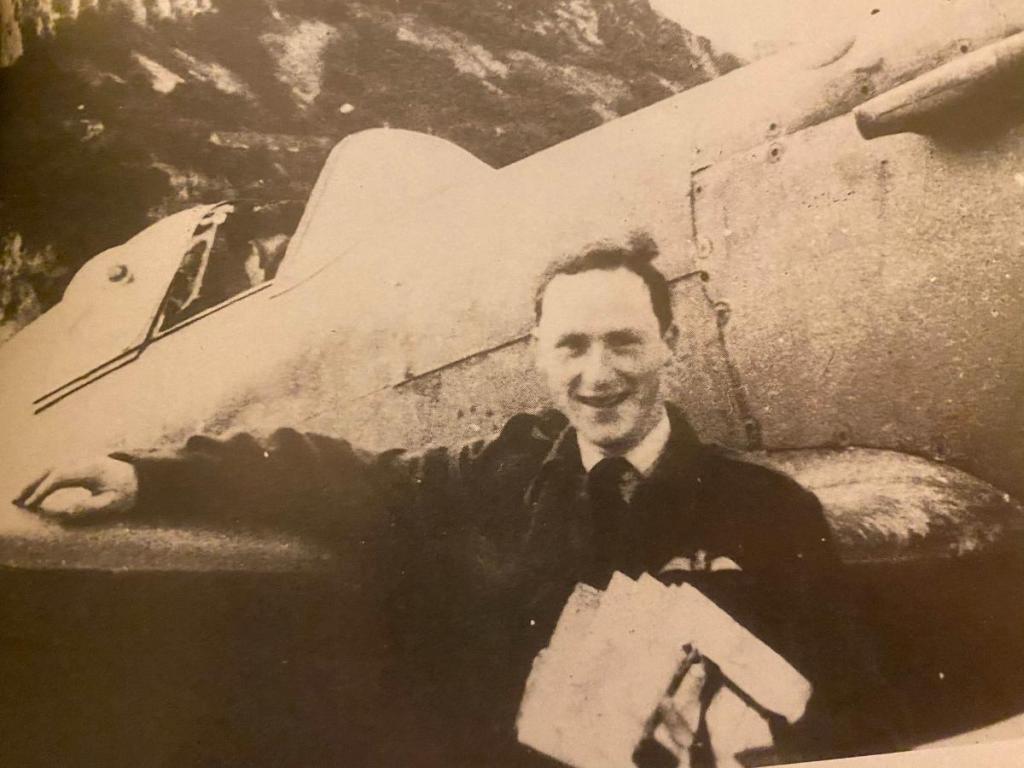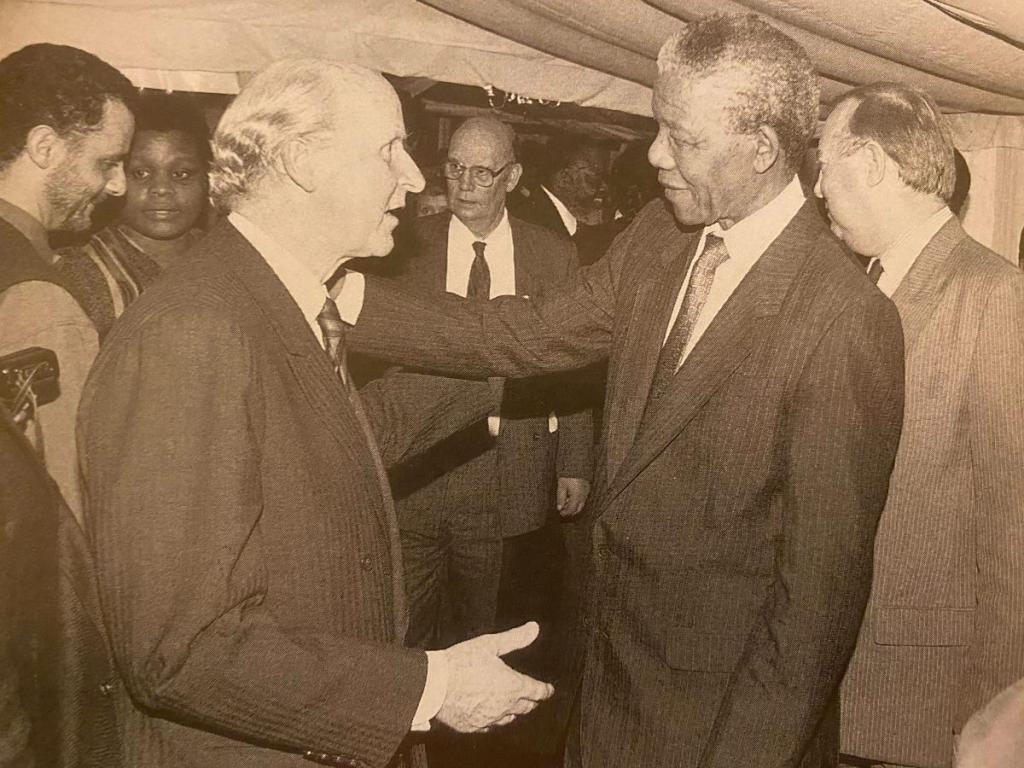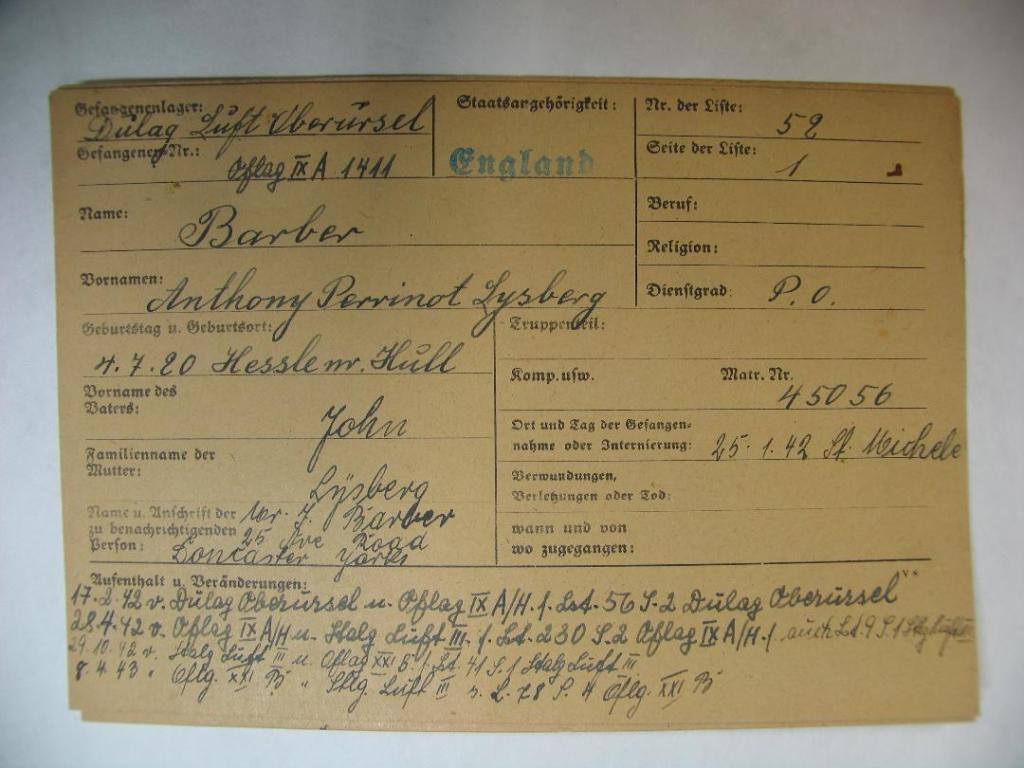-
Posts
220 -
Joined
-
Last visited
-
Days Won
11
Content Type
Profiles
Forums
Blogs
Gallery
Events
Store
Everything posted by POWCollector
-
Next up is a group that I took a researching gamble on and sadly have come up short. That being said, I am nevertheless delighted to have the group in my care. Robert Allan Campbell McClure was born on the 24th of February 1907. He was educated at Harrow School. His father, James, was a Physician. Robert was commissioned into the 8th Battalion of the Argyll and Sutherland Highlanders at the start of the Second World War and was sent out to France with the BEF, forming a part of the 154th Highland Infantry Brigade but was fortunately evacuated before the Germans could capture the rest of the 51st Highland Division at St Valery. Robert promoted to Lieutenant in February 1941. Moving with his unit to North Africa, Robert was captured on the 2nd of November 1942. I have not been able to find out the circumstances of his capture so if anybody can help me on this that would be brilliant! Robert would have been held in North African for a short while before being shipped over to Italy. It was whilst he was in Italy that Robert was awarded the Mention in Despatches for his services in North African. Robert was sent to PG35 at Padula, the most luxurious and picturesque of camps in Italy (see photo) which was an old monastery. In August 1943 with an invasion looming, the POW's were moved north to PG 19 at Bologna. On the armistice on 8th September 1943, there was a delay in releasing the POWs which allowed the Germans to surround the camp. When the POW's tried to escape through the main gate, the Germans opened fire forcing the majority of the POW's back into the camp. Robert was subsequently entrained for Germany and spent the rest of the war at Oflag 12b at Hadamar. Whilst at Hadamar, Robert would have been incarcerated with the 2nd Earl Haig before his transfer to Colditz castle; Haig was sent to Colditz in late 1944 and held as a prominente prisoner owing to his father First Marshall The Earl Haig. Oflag 12B was liberated on the 26th of March 1945 by the Americans and Robert made his way home. He passed away in 1992. I have been lucky to acquire Roberts ww2 service medals and miniatures along with a crucially named Harrow School gym champion medal dated 1925. I have also been fortunate to discover a photo of Robert with the 8th Argyll and Sutherland Highlanders officers prior to embarkation for North Africa. Robert is back row, far right.
-
I have recently upgraded my Findmypast account to include Newspaper Archives and I am so happy I have as I have found not one but two pictures of David! Regulars of this thread know how much I love having a face to the name! The first shows a picture of David prior to capture along with one of his brother who it turns out was also a POW! The second is outside the gates of Buckingham Palace after having collected his MM!
-
Apologies for the delay in posting - Ive had a hectic few months in which i've bought a large amount of new and exciting groups! L/Cpl G Lindsay enlisted into the Durham Light Infantry in 1938 and was given the service number 4456581. On the outbreak of war he was placed into the the newly formed 10th battalion of the 70th infantry brigade of the 23rd (Northumbrian) Division. In his civilian life, he worked as a lorry driver. Lindsay was serving in France when he was captured on the 20th of May 1940. His MI9 Debrief takes up the story: "I was taken prisoner near Doullens on 20 MAY 40 when my platoon was ambushed. We were taken by lorry to Amiens. Here ten days later I was able to break away and make my way through Bourlogne, Etaples, Calais, and Frevent to St Sauveur where i found shelter for three months. On 30 Sep, I crossed the Somme and went to Paris where I spent a month. I was then given a lift to Libourne, where I crossed the line into unoccupied France. At Perigueux I was arrested and sent to Marseilles, from where I got away in Dec 40. I crossed into Spain and spent nine weeks there in concentration camps before my release and repatriation." Lindsay left Gibraltar on the 11th of March and was interviewed by Lt Col Anstruther on the 19th of March 1941. He was subsequently awarded the Mention in Despatches for his escape which featured in the London Gazette on 15JUL41. Further research undertaken by myself has unearthed that Lindsay escaped from France into Spain with 3x others. These were: Sgt F Nicholson Wiltshire Regiment, Cpl H Radford, and a civilian Mr O'Connell. The date they set off from Marseilles was 22DEC40. The group crossed the frontier at Collioure, were arrested, and taken to Figueras later being transferred to Miranda Del Ebro. Miranda was the largest of roughly 200 concentration camps in Spain during the war years and conditions were awful. Much more insight into Miranda can be gained by visiting the following page: https://ww2escapelines.co.uk/article/miranda-de-ebro-spanish-concentration-camp/ Lindsay subsequently transferred to The Royal Engineers as a driver and returned to action with service in North West Europe during 1944 and 1945. After the war was won, Lindsay formed part of the British Army of The Rhine and was based in Germany until May 1946 when he returned to his civilian life. I am very happy to finally have a Miranda Del Ebro Escapers group. Lindsay and his comrades would have endured many hardships in the perilous trek over the Pyrenees Mountains in the exceptionally harsh winter conditions that the late December crossing would have brought. Along with Lindsays 1939-45 star, France and Germany Star, and War Medal with MID, I have a number of original documents from his time with the BAOR, a Mixed Service Organisation (BAOR) cap badge and a couple of photos so this is a really nice and complete grouping. Hope you enjoyed, much more to follow!
-

My Australian POW Collection
POWCollector replied to BustersPOWs's topic in Great Britain: Orders, Gallantry, Campaign Medals
Awesome group and really unusual story behind the medals too! Congrats on such a great find! -
Up next is a rather nice group which has been very crudely mounted, I believe, by the recipient. John Herbert Davison was born on the 26th of September 1919 and was a native of Newcastle, England. Before the war, John worked as a Weighing Machine Apprentice and lived at 94 Hamilton Street, Newcastle-on-Tyne. He joined the Territorial Army on the 2nd of May 1939, joining the 124th Field Regiment of the Royal Artillery and became 907403 Gnr J H Davison RA. On the outbreak of the second world war, John was mobilised with the 124th Field Regt RA and served with the British Expeditionary Force in France from Spring 1940 until they were evacuated on the 31st of May 1940 and returned to The UK. John stayed with the regiment and went on to serve in the middle east,(Iraq and Syria), before moving onwards to Egypt and Libya. John was captured with the regiment at Tobruk on the 20th of June 1942 and thus began his time as a Prisoner of War. John was initially held at the Tarhuna Camp in Libya from the 27th of June to the 17th of October 1942. John listed the commandant, an Italian Black Shirt Officer, on his 'Black List' on the MI9 POW Debrief form with the following statement: "Capitano Ronaldo Levite - Commandant of P/W Camp at Tarhuna, Libya between June and October 1942. His behaviour, while falling short of actual brutality, was particularly anti-British." After his spell in Tarhuna, John and his companions were moved by sea to Italy. He was held at PG 68, Vertralle from the 24th of October 1942 to 2nd of Jan 1943 when he was moved for 4 months to PG 65 at Gravina and thence to a work camp in Foggia. This work camp was sub camp 8 of PG 132 which was located in Lucera. John was at this work camp from 1st of May 1943 until the 22nd of August 1943 when he was (luckily) injured and sent to Barletta. Barletta is located about an hour and a half drive south of Lucera. John was in the hospital at Barletta at the time of the German airborne invasion. On the 11th of September 1943, Regiment 1 of the Fallschirmjager was ordered into Barletta to disarm the Italian troops based in the town. This was the first conflict between the German and Italian forces and a fierce battle commenced with both sides taking casualties. The next day, the German troops were reinforced with their number now totalling 1000 and air strikes were launched on Barletta resulting in further Italian casualties. 11 Italian community police officers and two street sweepers were picked up by the Germans, marched to the post office, and shot on the spot. One Police officer was wounded but the rest were killed. John along with his companions held out at Barletta Hospital until the 23rd of September when he escaped and made his way south. He describes this in his MI9 interview: "From Barletta Hospital, Walked south with some companions (names and units of these not known but they were last seen in U.K). He travelled on foot the whole way, receiving no assistance, and joined the Allied lines south of Barletta." John had successfully escaped a very dangerous area with the Germans taking full control on the 24th; the day after the escape. He was subsequently sent back to The UK where he was retrained and re-deployed to North Western Europe earning himself the France and Germany Star. Barletta town was later awarded both the Military and Civilian versions of the Gold Medal for Valour. The citation for the military award reads as follows: "On 8 September 1943, the garrison of Barletta, modestly armed, but supported by the spontaneous and effective support of the citizens, wanted to continue on the path of honor and loyalty to the homeland, strenuously opposing the fierce German units and inflicting considerable losses on them. Only on 12 September, after the arrival of overwhelming German reinforcements, the garrison, tried by the losses suffered and under the threat of the destruction of the city, was forced to surrender. The enemy troops, occupied Barletta, barbarously slaughtered 13 defenseless citizens in retaliation, who thus united their sacrifice to the valor of the military in a common yearning for freedom. The city of Barletta, a shining example of the virtues of the people of southern Italy, hands over to future generations the witness of the values resulting from the rebirth of the homeland and the conquest of democracy and peace. Barletta 8-13 September 1943." The citation for the civilian award reads as follows: "Occupied by German troops in the aftermath of the armistice, the city became the protagonist of a courageous and tenacious resistance. Subject of a ferocious and bloody reprisal, he counted numerous victims among the soldiers of the local garrison and the civilians who, helpless and exhausted by deprivation, were in many cases passed to arms on the place where they attended to their daily occupations. Splendid example of a noble spirit of sacrifice and love of country. 12 - 24 September 1943." I am delighted to have acquired this brilliant group with the crucially named Territorial Medal as John was held in two new camps for my collection (PG 68 and PG132) and also John and his companions made a brilliant escape in a very dangerous position. I was shocked to learn about Barletta and the brave efforts made by the Italian people but I am glad to have furthered my knowledge of Italy in September 1943 and this is truly a case of 'The story is far more important than the medals'. I have found photographs of the victims of the barbaric massacre at Barletta in their final moments and will add these to the post. May they rest in peace.
-
Next up is a rather nice new(ish) group to another Italy escaper. Arthur George Hindes was born on the 17th of April 1918. On the outbreak of the second world war, Arthur was a Brass Founder by trade. He was 5'8 with fair hair, a fair complexion, and blue eyes. His On the 15th of January 1940, Arthur enlisted East Yorkshire Regiment and was assigned to the 5th Battalion. His service number was 4346305. The 5th Bn East Yorkshire Regiment served with the 69th Infantry Brigade, 23rd (Northumbrian) Division where he would likely have served at Dunkirk before being evacuated back to The UK. The battalion was posted to North Africa where it saw action at Mersa Matruh. Subsequently, the now L/Cpl Arthur Hindes and his comrades were present at the first battle of El Alamein, Egypt in July 1942. They were captured on the 27th of July 1942 by the Germans. Under his 'brief circumstances of capture' section on his MI9 report, Arthur said the following: "Having made a night attack and when digging in, the position was overrun by German tanks". Arthur was first held at the infamous Benghazi cages between his capture date and the 15th of August 1942 before being transported to Italy, arriving the next day. In Italy, Arthur was held at PG 85 Tuturano until 20th August '42, then he was moved to the transit camp PG75 at Bari for 2 months before being sent on to a more permanent camp. This was Campo 70 at Montalbo. Arthur spent 7 months here before being transferred to a working camp, PG 146 (sub camp 9) at Massalengo in Northern Italy. Here he was employed as a Farm Labourer. On the Italian Armistice in September 1943, Arthur and his camp mates held at the working camp escaped and a group of 10 other ranks (including Arthur) sought shelter which they received from a Giovanni Chioda. This man housed and fed the party of British O.R's for 2 weeks before Arthur and 3 friends were passed on to a Roman Catholic Priest, Father Roveda. Father Roveda housed and fed the escaped POW's for a month and also supplied them all with crucially important civilian clothing. After this month of care, Father Roveda made contact with an Italian escape organisation who took over and arranged the safe passage of the escapers into Neutral Switzerland. It is interesting (to me) to note that the Roveda surname derives from Hungary and the name meant that the person was literate. Numerous Hungarian families living in Austria immigrated to Italy and, once in Italy, these families with the surname 'Roveda' were forced to convert from Judaism to Catholicism. Not only did this religious conversion clearly work for Father Roveda to take up priesthood, but this forced conversion from Judaism may well have saved the lives of him and his family members in Italy. Back to the story.... The Italian underground movement organised passage for Arthur and his comrades to a safe-house in a Commune called Asso in the Province of Como on the Border of Switzerland. From here, a Swiss man from Geneva named Guido Della Beffa guided the party over the border and to his house at Rue Grande 23, Geneva, Switzerland where he housed and fed the group for 5 days. They arrived in Switzerland on the 21st of October 1943. Arthur George Hindes was held in Italy until he could be returned to England and he was discharged on the 29th of December 1944. I was very happy to receive this interesting grouping relating to Arthur Hindes a few months back when the National Archives were closed and was so happy to find his MI9 Escape and Evasion report with its added detail. The grouping consists of Arthur's WW2 medal entitlement : 1939-45 Star, Africa Star, and War Medal along with his Army Pay Book. Without the Pay Book, there would be no way of identifying the medals so I am so grateful it was kept! I hope that you have enjoyed this post; I have a LOT more to post over the Christmas leave period so stay tuned.
-
Thanks very much, John! I love the group to Alexander too. As you know, i've been searching for Commonwealth POW groupings captured/held in Europe for years and we both know how tough it is to find Canadian groups! I've got some great groupings to come in the following weeks, hopefully i'll have lots of free time over Christmas leave to share them. Well done for your acquisitions in 2021 and thanks for sharing. Look forward to more next year. Rob
-

My Australian POW Collection
POWCollector replied to BustersPOWs's topic in Great Britain: Orders, Gallantry, Campaign Medals
Briliant posts, Buster! Excellent research and I love how unique both of these stories are! Please do keep them coming! -

My Australian POW Collection
POWCollector replied to BustersPOWs's topic in Great Britain: Orders, Gallantry, Campaign Medals
Great post Buster! I love it when photos of the recipients are present! I really look forward to seeing more of your collection and watching it grow! As you may have noticed from my collection, I’m still yet to find a good Aussie grouping. I’d love more than anything to find an RAAF European Theatre pow group some day… -
Hi All, I am struggling worse than ever with my research and wonder if any members who are particularly good at researching gunners can assist me? The man I’m trying to research is: 1598338 A Sjt Charles Henry Payne Royal Artillery. He was captured in December 1942 in North Africa, held in Italy and escaped for which he was awarded the Military Medal but I can’t find the citation or official recommendation. Please see Find My Past entry attached. If anybody could assist me I would be so so grateful! Rob
-
Amazing research! I haven’t seen many Boer War groups (nor even 1st/2nd World War) where the circumstances of capture for an individual is documented! Other than those listed on Gallantry medal citations, I’ve only 1 group in my collection where this info exists! Excellent detective work on confirming the alias too! Great posts.
-
In continuation with my current commonwealth captive's collecting.... Here is a Canadian. This is my first Canadian POW group and I am absolutely delighted with it due to there being 4 new medals to my POW collection (including Silver Canadian defence and war medals as new!) This is an historically important find. Ernest Joseph Alexander was born on the 22nd of April 1918 in Ottawa, Ontario, Canada. I have not ascertained the name of Ernest's father, but his mother was Violet. Ernest was living in Montreal, Quebec when the second world war broke out and he was working as an Elevator Operator. He had previously served 2 years in The Royal Highland Regiment of Canada (The Black Watch) and so on the 9th of September 1939, he rejoined his old outfit. He was now D-81251 Private E J Alexander RHC. Ernest was 5 feet and 7 inches tall, had brown hair and a fair complexion. In my research, I found out that Alexander is actually a strong Jewish surname and this is cemented by Ernest's service record... Under languages spoken, Ernest is noted as being fluent in: English, French, German, and *Hebrew*. Ernest trained in Canada and Newfoundland before sailing over to Scotland arriving here in October 1940. He undertook lots of training courses in the UK and interspersed these with several periods of AWOL's for which he would always have to forfeit some pay! He was initially in the intelligence section of the Royal Highland Regiment before becoming a Platoon Runner and then Company Runner. This was an exceptionally dangerous job and Ernest must have been incredibly fit to have been given this job for 3 years! By this time, he had also been promoted to Lance Corporal. On the 5th of July 1944, Ernest and his comrades in the 1st Battalion embarked in the UK for France to join the fight in Normandy and they arrived the next day. The travelled on the small cruising vessel 'The Isle of Guernsey' along with The Regiment De Maisonneuve and The Calgary Highlanders. Conditions were very cramped with each room averaging 58 men. (Picture of ship below found on rollofhonour.com) The days were fairly eventful as the Canadians made their foothold in Normandy with constant arial bombardment and strafing from enemy aircraft. The 1st Battalion, Black Watch of Canada war diary highlights this: "Franqueville, Monday 14th July 1944 Weather - Clear and very warm. Bastille day was celebrated at ROTS today. The guard of honour was provided by the Regt de Masionneuve, our Bn. sending over as representatives Sgt Carton from B.Coy. and Cpl Lessard from the I. Section. They reported that it had been a most interesting and impressive ceremony and that it had been broadcast in French to L'ontreal. A straffing raid was made by 12 Focke Wulf and M.E.109s and of the three shot down, one fell in flames in the are of the Regt de Maisonneuve. Shells fell in our D.Coy area wounding Sgt Hulley and *L/CPL ALEXANDER*." Ernest had been wounded in his left hand and arm but was otherwise fine. The Battalion suffered a great deal more casualties over the next 10 days until, on the 25th of July 1944, they suffered a catastrophic loss of 94% of the men. This was the Battle of Verriéres Ridge. This was the costliest day for a Canadian battalion since Dieppe in 1942. The part of the 1st Black Watch of Canada was a broad daylight rush of a ridge defended by SS Panzer Divisions. Of the 325 men who were present from the 1st Battalion, only 15 made it back to friendly lines. The rest were all Killed or Wounded and captured by the Waffen SS. This is a good overview of the battle: https://www.nationalww2museum.org/war/articles/black-watch-verrieres-ridge-july-1944 Under the section stating 'Type of Employment within unit', Ernest's service record states: "Company Runner (Royal Highland Regiment). Drawing and Enlarging Maps. Held same job until wounded and taken prisoner on 25 JUL 44." Ernest was wounded when captured having sustained injury to his left cheek which caused permanent scarring along with a fractured Jaw. This wound caused him to have Lock-Jaw. He was sent to the Pitié-Salpêtriére Hospital in Paris, France arriving here on the 27th of July. With the liberation of Paris by the allies and the evacuation of Axis Forces in mid August 1944, Ernest was moved to Germany. He left the Paris Hospital on the 15th of August and arrived at Stalag IV-b at Muhlberg on the 15th of September 1944. Here he was held until he was 'liberated' by the Russians in April 1945. He was held as a prisoner of the Russians until May 1945 when he was interviewed by MI9 and subsequently sent back to the UK. On his MI9 liberation report, Ernest has made a curious remark on the section of Interrogation as below: "Interrogated Chalons, France. Verbal Interrogation. Polite and Courteous. They knew more about me than I knew myself". I am very intrigued as to what this refers to, but sadly, we shall never know. Could it have been to do with his Jewish heritage? Could this be related to the battle in which he was captured? Who knows. After the war, Ernest returned to Canada and married a miss Dorothy Jones. He was demobbed in 1947 and awarded: The 1939-45 star, France and Germany Star, Defence Medal, War Medal, Canadian War Service Medal with overseas clasp, and the Territorial Efficiency Medal with Canada clasp. This last medal is the all important one as it is named! I am thrilled to have acquired this truly magnificent group to a brave man who fought in a truly bloody campaign. The fact that he was of Jewish heritage makes this even more appealing to me as it must have been a scary thought whilst in Germany as a prisoner of the Reich!
-
My second Kiwi grouping is sadly a short one until I can get a hold of a service record from the New Zealand archives. Selwyn James Tregear was born on the 11th of November 1911 in Christchurch, New Zealand. His parents were Neville Atherton Tregear and Ethel Jane Tregear. Selwyn was the second of 4 children. He had an older brother named Lance Neville, a younger sister named Isla Evelyn, and very sadly his youngest sibling, Lyell, died only 7 days old. Selwyn's mother, Ethel, passed away in 1933 and his father re-married a woman named Murial. When war broke out Selwyn attested into the New Zealand army and became 9442 Driver S J Tregear NZEF. He served in the supply column. At the time of enlistment, he was living at 5 Locarno Street, Opawa, Christchurch, New Zealand and his trade was noted as a 'Civilian Machinist'. Selwyn's unit was involved in the fighting in Greece before retreating back to Crete and it was here to Selwyn was captured by German forces. He was given the POW number 5448. He was initially held in the awful transit camp at Salonika, a disused Greek Army barracks on the outskirts of town. This transit camp was more often remembered by its inmates as a starvation camp with a highly inappropriate amount of medical supplies. Some prisoners stayed here for as short a time as 24 hours, some stayed for periods of several months whilst they were being used as slave labourers by their captors. I do not know the exact amount of time that Selwyn stayed here but I hope it was not long! After his stay at Salonika, Selwyn was put on a cattle truck and would have spent a hellish week long journey through the Balkan states up into Poland at his permanent POW Camp, Stalag 344 at Lamsdorf. Selwyn appears to have stayed the rest of the war at Stalag 344 and would have almost certainly endured many hardships on various work camps and, of course, the infamous march Westwards away from the Russian advance in the winter of 1945; A march which claimed the lives of many POW. He was freed in May 1945 and in due course returned to New Zealand, passing away in Canterbury on the 30th of May 1982 in his native Christchurch. His probate documentation describe him as 'A War Pensioner'. I have in my collection Selwyn's full WW2 medal entitlement of: The 1939-45 star, Africa Star, Defence Medal, War Medal, New Zealand War Service Medal, and lastly his Greek War Medal with named certificate. The certificate is absolutely crucial due to the New Zealand government not having named their medals when issued. It is also lovely that Selwyn's Greek War Medal is the Gilt version rather than the Bronze variant. I am very glad to have secured my second New Zealand POW medal group as they are so scarce and hard to identify!
-
Next up is another great South African group awarded to a man with potentially the best name i've ever heard! Jacob Johannes Peterus Stephanus Breytenbach was born on the 7th of March 1912 in Middelburg, Transvaal, South Africa. Before the Second World War, Jacob was a farmer living in Kinross, Transvaal, South Africa. Jacob enlisted as an Air Gunner in the South African Air Force in June 1940 but he was deemed 'Unlikely to become an efficient air gunner' and transferred to the 2nd Battalion, Transvaal Scottish Regiment, part of the 2nd South African Division on the 7th of December of the same year. He became a part of the Heavy Weapons Support Company. After infantry training, Jacob disembarked in Egypt in June 1941 before moving on to Libya. Jacob and his comrades fought in the following battles: Halfaya - 12th to 17th of December 1941 Sollum - 11th to 12th of January 1942 Acroma Keep - 06th to 18th of June 1942 Jacob was serving at Tobruk when the regiment was captured on the 21st of June 1942. Jacob interestingly managed to break through the lines but was picked up by Axis forces on the 22nd of June in the Tobruk area. Whilst in Libya, Jacob was lectured on 'How to behave in the event of capture' by a Captain D Dale. After being held in North Africa, Jacob was transported to Italy staying for a couple of months at Campo 77, Pissignano Campello, before arriving at his final Italian camp on the 27th/28th of September 1942. This was Campo 54 at Fara Sabina which was approximately 40 miles North East of Rome. On the Italian Armistice in September 1943, Jacob escaped into the surrounding country side. However he was recaptured in December 1943 by the Germans. His MI9 POW Debrief takes up the story below: "When Italy packed in, I spent 3 months in the hills near Tivoli & Rome before I was recaptured by the Germans. Given away by the Fascists for 2000 Lire. My pals as well." Jacob and his pals were taken by train to Germany and he arrived later in December 1943 at Stalag 8B, Lamsdorf. From Lamsdorf, Jacob was again transferred in February 1944 to Stalag 4b at Muhlberg. Jacob was released from Stalag 4b in May 1945 and was interviewed by MI9 on the 26th of May 1945. He was flown back to the UK on the 29th of May '45 and returned to South Africa by sea on the 19th of July, arriving on the 3rd of August 1945. In January 1946 he was discharged with a character description of 'Very Good' and thence returned to Transvaal and his farming career. He applied for his medals (pictured below) which were dispatched on the 15th of April 1953.
-
Next up is a fantastic group to a South Africa Policeman which is new to my collection. Harold Julius Bates was born on the 15th of May 1914 in East London, Cape Province, South Africa. In 1933, Harold joined the South Africa Police in Pretoria. He was given the service number SAP196993 and held the police rank of 'Constable'. He served in the 14th district, Port Elizabeth. With the second world war unfolding, Harold was mobilised with the 2nd Battalion, SAP on the 3rd of June 1940 and was sent to Egypt in June 1941. His rank was now 'Private'. In September 1941, Harold had an accident whilst digging a trench. The pick he was using to dig struck a rock and the pick lodged itself into his left ankle causing a deep wound with heavy bleeding. An incident report showed that Harold was Sober, was not acting with negligence and that the incident occurred whilst performing his ordered duties. Harold and the rest of his battalion ended up stationed at Tobruk and were involved in the attempted break out on 20th of June 1942 when they were surrounded by Axis forces but they ultimately had to surrender the garrison. Harold was not wounded. On captured, Harold was initially held in the infamous POW cages in Benghazi, North Africa from the 20th of June 1942 until the 7th of November 1942. Conditions at this place were vile and it was here that Harold contracted Dysentery which persisted for 4 months. He states that very little medical supplies were made available and that he was not provided adequate medical treatment. On the 14th of November 1942, Harold arrived at PG 75, a transit camp in Bari on the coast of Southern Italy and after a short stay was transferred to PG 132 at Foggia where we worked on a local farm as a labourer arriving here on the 1st of February 1943. This would have been very beneficial as those who conducted work whilst held prisoner in Italy tended to have fared better; this was more often than not as their 'employers' would give them additional food rations. Harold stayed working on this farm for just over 6 months until the capitulation of Italy came in early September 1943. Harold states that he was at this work camp until the 10th of September. It is highly plausible that Harold enjoyed some free time in Italy at this point as he is next recorded at Stalag 8c in Sagan, Poland on the 28th of September. Sadly, lots of POW's did not see the period between the Italians capitulating and the Germans recapturing them as escapes and, as such, did not record their exploits on their MI9 debrief forms. However, I do believe that this is the case for Harold considering that the journey should not have taken more than 5 or 6 days and as a prisoner in Southern Italy, it would have been deemed prudent by the Germans to move these men quickly away from the advancing allies. Back to Stalag 8c in Sagan.... Harold once again utilised on work parties. His first job was labouring at the Breslau post office which he commenced on the 1st of December 1943. He wrote about his experiences at the post office as so: "Whilst employed at the post office of Breslau from 1/12/43 to June '44, I and my comrades sabotaged numerous parcels and misdirected hundreds of mail bags by changing the labels and names." This must have been very good for morale and the thought of act of sabotage made me laugh! After his time at the Breslau post office, Harold was tasked in June 1944 to dig civilian air raid shelters which he continued with until the 24th of January 1945. At this time, it was clear that the Russians could not be stopped in their advance and on the 25th of January the prisoners were forced to start marching in a westerly direction away from the Russian advance. Many prisoners utilised this forced march to make escape attempts and Harold Julius Bates was one of these individuals. He takes up the story on his POW debrief: "Attempted to escape whilst on a forced march in Germany by burying myself in hay on a farm accompanied by Benson and Jordan Anderson. Attempt failed owing o the use by the Germans of trained Alsatian dogs. All recaptured. We were all at this time in very low physical state owing to starvation." Harold re-joined the line of march and was liberated on the 12th of April 1945 by the allies. He was interviewed by MI9 on the 20th of May 1945. Harold was repatriated to South Africa in July 1945 and went back to policing in Pretoria. I am so delighted with this group as it is my first South Africa Police grouping and the MI9 debrief has a great amount of detail. I am particularly pleased with the act of sabotage at Breslau Post Office as this feels like such a childish, schoolboy prank to play but the actual ramifications and disturbance to the postal system would have actually been very disruptive to the Germans. However, The escape attempt listed is what made me think 'I have to acquire this group'.... Having grown up watching Films and TV shows such as: Colditz, The Colditz Story, The Great Escape, The Wooden Horse, Albert RN etc.. there always seems to be a scene where Alsatians are used to foil a plan so carefully constructed. I am so happy, therefore, to finally have a group in my collection where the escape plan was foiled by the hounds! I suppose that proves that the story really is key when it comes to these so-called 'standard' WW2 medal groups. The story of Harold Julius Bates appeals so much to me and I am thrilled to be the new owner of this fantastic group.
-
Next up is the most special and poignant grouping in my collection (to date) and that is a big statement! Derek Kenneth Measures was born on the 6th of July 1922. Before the war, he was a civil servant living in Surrey, England. Derek joined the Royal Air Force on the 23rd of June 1941 and after training (unsure of air crew trade) joining 77 Squadron flying in Halifax aircraft. On the night of 19th/20th February 1944, the first day of 'Big Week' Operation Argument, Derek and his crew were flying in Halifax HR949-H as a part of a force of 700 bombers with the target city of Leipzig. Derek takes up the story in his post war account: "I was flying a Halifax on the night of 19th Feb 1944 to bomb Leipzig. We had been hit on the trip out but after the bombing on our return trip we ran out of fuel and had to bale out south east of Calais. I landed at about 06:30 hours near a farm where I called in but could obtain no assistance and so made off south with the rough idea of getting to Spain. I walked to Auxi Le Chataeu where I arrived about 17:00 hours and laid up in a hayloft for the night at about 15kms on the other side. I walked the best part of the next day and arrived at Franqueville where I contacted a small farming family (names unknown) who immediately passed me on to a man who later became known to me as 'The Airmen Hider'. I was also provided with civilian clothes. The airman hider was a man of about 55, his house being second from the end of the village on the right hand side going south. A woman friend of the family contacted the local underground, who after three days, moved me to Vignacourt where I stayed for about 16 days with a member of the underground. The idea was to get me to Switzerland but this fell through as the guide got caught. I was then moved to St Leger, near Berteaucourt, where I was again hidden up in four different houses for a period of a fortnight. I was joined here by an American airman by the name of Jim Bailey (S/Sgt). We were then moved together to Domart-En-Ponthieu where I was due to catch a plan back to this country (England). Due to an RAF raid on Amiens, all cars were requisitioned and it was not possible to obtain one to take us to the place where we were to be picked up by plane. At the end of seven days and due to a Gestapo source, we were moved back to Bertaeucourt, having spent a day in the home of old people in Domart-En-Ponthieu. We were kept here for three days and then moved back to Franqueville where we were hidden by a farmer for a week. At the end of this time we were moved back to Bertaeucourt and hidden up at the house of a woman and her husband. Due to, we thought, the woman in the house next door informing the Gestapo, these turned up at the end of two days (06 Apr '44) and picked us both up including the woman of the house. The husband, who was working in a factory at the time was warned and he was not picked up. We were taken to Gestapo HQ at Amiens for normal interrogation and locked up in Amiens Citadel for seven days in solitary confinement. We were then moved to the military prison in Amiens and kept there for about 3 weeks, where we were interrogated at regular intervals. We where then moved to Fresnes prison, Paris on the 5th of May 1944 and I was kept there until the 15th of August 1944." On the list of helpers provided by Derek, it is stated that Madame Bezairy (his final shelterer) was sentenced to 12 months in a concentration camp for helping him. During the period when cycling between Franqueville and Domart-En-Ponthieu, Derek and Bailey cut the military telephone lines as an act of sabotage. Moving back to Derek, he had found himself in the most precarious of positions that an allied solider could be in. In an occupied country, in civilian clothing and in a resistance safe-house. Fresnes prison was a place of evil, run by fanatical Nazi's who did not have respect for their fellow human beings and certainly did not abide by the Geneva Convention. Derek was certainly tortured during his time at Fresnes and would have heard the screams of fellow airmen and resistance members every day that he was there as well as the never ending firing squads. He would have endured the toughest conditions and deprivations all of human necessities. On the 15th of August 1944 just a few days before Paris was liberated, Derek Kenneth Measures along with 167 other allied airmen were crammed into cattle trucks and deported to BUCHENWALD CONCENTRATION CAMP. These men were labelled as Terrorflieger (Terror Fliers) and as such treated as worse than saboteurs and spies. They were sent to Buchenwald to be liquidated. These men would become known as the KLB Club (Konzentration-Lager Buchenwald). Buchenwald was established in July 1937 and house 280,000 inmates all many different nationalities. The reasons for imprisonment ranged from: Political opinions, race, religion, mental disablement, criminal acts, and sexual orientation. Similar to the motto 'Arbeit Macht Frei' which haunts the gates at Auschwitz Birkenau in Poland, The main gates of Buchenwald had the phrase 'Jedem das Seine' which translates as 'To each his own'. The German SS interpreted this to mean that 'The Master-Race' had the right to humiliate and destroy others. This is a chilling message in itself and must have been a terrible omen for the 168 Airmen as they arrived at the camp. The Airmen were taken off to have their body completed removed of hair and they were issued the, now infamous, blue and white striped pyjamas. They had all of their civilian clothes taken from them but they were not issued shoes to replace the ones taken. They were housed in 'The Little Camp' where they could expect the harshest treatment with the least amount of food. The Airmen had to sleep outside with no shelter. The little camp was adjacent to the medical experimentation block and a feared place for all those at Buchenwald. Thus began the even more precarious life of Derek as prisoner 78413 at his new home, Buchenwald Concentration Camp. On arrival at Buchenwald, one man in particular stood out from the crowd. This was Squadron Leader Phil Lamason, a New Zealand Pilot who had been awarded the DFC and bar. He was a natural leader and as such took charge of the men as their senior allied officer. After their first meal, Lamason addressed the group such: "Attention!... Gentlemen, we have ourselves in a very fine fix indeed. The goons have completely violated the Geneva Convention and are treating us as common thieves and criminals. However, we are soldiers. From this time on, we will also conduct ourselves as our training has taught us and as our countries would expect from us. We will march as a unit to roll call and we will follow all reasonable commands as a single unit." Lamason instructed the Airmen not to trust the Germans or provoke them in any way. They were not to explore the camp in fear of breaking any rules and they were to stay together at all times. He also organised the men into nationalities and appointed a senior officer for each nationality. He boosted the men's morale and instilled some military bearing and discipline. Lamason conducted several meetings with the camp authority to have them transferred to a Prisoner of War camp but this never came. The men's documents were stamped 'DIKAL' which stood for 'Darf in kein anderes lager' or 'Not to be transferred to another camp'. As Buchenwald was a slave labour camp, the 168 Airmen were expected to work. When Lamason was told be an SS officer that he was to instruct his men to work or he would be shot by firing squad, Lamason refused. A tense stand off ensued but eventually the SS backed down. Lamason had in the first few days befriended other captive allied personnel such as Edward Yeo-Thomas, 'The White Rabbit', and his SOE colleague Christopher Burney. Through these contacts, he was introduced to a Russian prisoner who worked at a near-by air field. Taking a colossal risk, Lamason and Burney persuaded this Russian to smuggle out a note to present to the Luftwaffe stationed at this air field. This risk paid off and eventually two Luftwaffe officers came to the camp under the pretence of surveying recent allied bomb damage. One of the officers spoke to Lamason and, convinced of the Airmen's genuine status, reported his findings back to Berlin which eventually fell into the hands of none other than Hermann Göring himself. Enraged by the news that 168 allied airmen were being held in Buchenwald and not in a Luftwaffe run camp, Göring demanded 'at the highest level' that the airmen be moved. By this point, Lamason had been informed by a German political prisoner (Eugen Kogon) that the execution date of the 168 Airmen had been scheduled for the 26th of October 1944. Lamason decided to keep this information to himself to maintain morale and in the hope that the Luftwaffe would be able to intervene in time. On the night of the 19th of October 1944, 156 of the airmen including Derek Kenneth Measures were removed from Buchenwald and transferred to Stalag Luft 3 at Sagan, Poland. Over a period of several weeks, 10 more airmen were transferred to Stalag Luft 3 but sadly two airmen perished at Buchenwald due to malnutrition and mistreatment. Derek arrived at Stalag Luft 3 and was given the POW number 8107 this must have been an overwhelming feeling after 6 months of Gestapo and SS Captivity. When they first arrived, the contingent of 156 Airmen were treated with distrust due to their shocking condition and many allied officers believed that they were spies. The men had been returned their civilian clothing and concentration camp pyjamas removed which would have added to the suspicion. Amazingly, there is a surviving photo below of a group of the men arriving at SL3 - Perhaps Derek is amongst them. In late January 1945, the camp was evacuated in light of the Russian advance and the men were sent to various camps around Germany. Derek was in the 3000 strong contingent sent North to Marlag und Milag Nord at Tarmstedt and arrived here on the 4th of February 1945. In April 1945, the men were once again marched away from advancing allied troops and the contingent was liberated by the British 11th Armoured division at Lübeck on the 1st of May 1945. Interestingly, Derek Kenneth Measures was liberated by the same unit on the following day (02MAY45) at a farm 15km from Lübeck so there is a chance that he slipped away from the column. I was absolutely amazed to find such a rare, historical, and emotive grouping and I am proud to have his medals and POW dog-tag in my collection to be able to share his story here. A story which could quite easily have gone unknown. I have Derek's 1939-45 star, Air Crew Europe Star, War Medal all mounted as worn along with his rather rusted but still just about legible dog-tag showing his Stalag Luft 3 number '8107'. I would encourage you all to watch the documentary 'The lost airmen of Buchenwald' to gain further insight into this dreadful event in history.
-
Next up is my first group to a New Zealander and it was a great find. As I am sure most of you are aware, The UK, New Zealand, and Canada did not name their WW2 medals (unlike S.A and Australia) so it is essential to find paperwork to identify the recipient. Ronald Clifford Mckay was born on the 26th of March 1917 on Cobden Street, Westport, which is on the south island of New Zealand. During the Second World War, Ronald enlisted in the New Zealand Army and was assigned to the 20th Battalion (South Island) of the 4th Infantry Brigade. The 4th Infantry Brigade, along with the Australian 6th Division and the 1st British Armoured Brigade were sent to Greece in early March 1941 to assist the Greeks in defending against the expected German invasion. When the Germans did attach on the 6th of April 1941, the battalion was stationed at the Aliakmon Line but slowly they were pushed to Porto Rafti and on the 22nd of April, the Brigade was evacuated to Crete. Whilst on Crete, the 4th Infantry Brigade NZEF was utilised as a reserve force in the area of Galatas. Due to the Axis advance onto Crete, the 4th was evacuated once again to North Africa from Sfakia on the 30th and 31st of May 1941. In North Africa, Ronald was promoted to Corporal and was attached to the staff of the 4th Infantry Brigade. They saw heavy action in the battles of the North African campaign and sadly, Ronald was taken prisoner on the 26th of July 1942 at El Alamein. Ronald was initially held in North Africa before being shipped over to Italy. Once in Italy, Ronald was sent by railway up to PG 57, A pow camp in the Northern City of Udine, Italy. This was situated on the borders of Austria and Yugoslavia (now Slovenia). PG 57 was run by the Carabinieri (an organisation with both Military and Civil power) and was commanded by Colonel Vittorio Calcaterra, a staunch Fascist described by one prisoner as 'A sadist & beast and an accessory to murder'. In September 1943, Italy capitulated and the men of the camp were able to make their escape into the Italian countryside and surrounding mountains. Ronald along with 5 others managed to evade German patrols and eventually met up with a band of Slovene partisans in August 1944. The partisans escorted the escaped POW's through the littoral into safety at Semič and left by aeroplane on the 18th of September 1944. Ronald arrived back in Christchurch, New Zealand on the 1st of February 1945 and was granted 88 days of leave before discharge. It was later discovered that the evil Fascist camp commandant, Vittori Calcaterra, was executed by the Italian Partisans in 1943 after the Italian Capitulation. I have Ronalds WW2 medal entitlement, cap badge, Army Paybook, and a few other loose documents and group photographs. One of these documents notes Ronald as an escaped POW which is a nice addition. I am delighted to have my first NZ POW group to a man confirmed as having made contact with the Yugoslavian Partisans and hopefully I will be able to discover some more information about his time on the run in Italy and Slovenia. Hope you have enjoyed this read.
-
Some more excellent new additions! The Syrian campaign group is a great find! I wonder how many (if any) managed to escape over the border to Turkey? Turkey differed from Switzerland in its neutrality as escaped pows would not be interned, but were sent across to Egypt and could get back into the fight quickly! One of my more recently groups was to a man who escaped from Crete and made his way to Turkey later being killed in action in NW Europe.
-
I have recently been reading 'The 21 Escapes of Lieutenant Alastair Cram' (which is a fantastic book and highly recommended!) and have stumbled across some further information about Major Henry Edwards. As mentioned, Whilst at Oflag VIII-F, Henry was involved in a tunnel with Captain Robert (Bob) Parrot of the Royal Artillery. Bob was a friend of Lt Alastair Cram, David Stirling the founder of the SAS, and Jack Pringle who were all held together at PG5 Gavi - the Italian Colditz. When the officers arrived at Oflag VIII-F in January 1944, they had a happy reunion which lasted all night recounting their tales of their attempted escapes from Italy after the Armistice and their subsequent recaptures. David Stirling quickly established himself as the leader of the escape organisation at Oflag VIII-F, thus he was aware of all the attempts being made and therefore would have known Major Edwards. Between January and March 1944, there were 3 tunnels being dug in the camp and the book takes up the story below: "Like the other tunnels, Wadeson's began from a building not too far from the double wire that surrounded the camp. Unfortunately, the high water table combined with seepage from the melting snow completely flooded it. When the same thing happened to Bob Parrot's tunnel, they tried to exploit the loss by sending an anonymous letter to the Germans giving away their exact locations. The author claimed to be a devout - though clearly mad - Christian who wanted to prevent the loss of life that an escape would provoke. In an attempt to lower the Germans' guard, the letter also promised to inform them of any future attempts. The ruse, if it worked at all, was soon undermined by the dramatic discovery of a third tunnel, directed by Herbert Buck. While he hadn't been in Gavi, Buck was a member of the SAS and a close associate of David's." It is fantastic to find out the reason behind the German's discovery of the tunnel and it is very nice to learn that Edwards would've been associating with such interesting and lively figures within the camp. After these tunnel disasters, David Stirling realised that the morale of the escapers in the camp was running incredibly low and wanted to remedy it. He came up with a daring plan which was to be the largest escape of the war with 200 participants. David petitioned to the commandant that the Scottish inmates were not able to perform their culturally important Highland Dance, and he wanted some timber to construct a platform in the theatre on which the prisoners could practice and later perform their dance. The commandant duly agreed and provided the timber and the prisoners took great pleasure in seeing the gigantic 6"5 frame of David demonstrating the moves. Davids plan was to deconstruct the planks of the platform on a certain night, fix them together, and use them as a gangplank running from the window of the theatre to the nearby wire. The 200 prisoners would then run across, jump over the wire and make their bid for freedom. Edwards would certainly have been one of those on the list to escape due to his friendship with Bob Parrot and his previous tunnelling experience, proving that he wanted to get out. It was very fortunate that the prisoners were transferred in May 1944 before the escape could take place due to the German High Command order decreeing that all recaptured prisoners should be handed to the SS or Gestapo and executed, similar to those murdered after the great escape. The news of the Great Escape did reach the prisoners, but they were not put off. Major Roy Wadeson (mentioned above) and Lt Hugh Mackenzie escaped from Oflag VIII-F on April 20th 1944 in order to make contact with the Czech underground looking for assistance with David's big escape. They had been supplied with 2 addresses by a civilian worker in the camp. They had not been heard from by the time of the camp move so Alastair volunteered to escape to find them and let them know that their job was no longer required. Alastair went to the addresses but found out neither existed and surmised they had been betrayed. He was recaptured later that day. Taken to a civilian prison, he ended up in a cell with Des Plunkett, the last of the great escapers to be recaptured which had saved his life. After 2 months, Alastair was taken transferred on to Oflag 79 to rejoin the rest of his old camp. Des Plunkett was held for many more months in solitary confinement being forced to listen to torture, firing squads, and the sound of the 140lb guillotine crashing down. He was eventually sent to Stalag Luft 1 in Barth where the other prisoners (mostly US aircrews) did not trust him and thought him to be a German spy. He attempted suicide around this time as he believed that information he had given in his torture from the Gestapo had caused the deaths of his 50 friends. In reality, Des was recaptured on the 8th of April, a week after the last of the murders took place. David Stirling and Jack Pringle escaped again from Oflag 79, were recaptured, and were finally sent on to Colditz, from which they were liberated in April 1945. It was later found out that Wadeson and Mackenzie had in fact been captured in the trap, tortured and executed in the same manner as the Great Escapers. The official cause of death was 'Shot whilst trying to re-escape'. Their ashes were sent to Oflag 79 in unmarked urns and they were given a military funeral. In 2016, their bodies were re-interned in a Commonwealth War Graves Commission cemetery with Wadeson's son in attendance. Note: Henry Patrick Edwards was liberated from Oflag 79 in April 1945, not 1944 as previously stated in error.
-
Next up is, without a doubt, the pride of my collection and will be a VERY long post and it is a condensed version of 5 years of research but it is worth a read. Anthony Perrinott Lysberg Baber, known as Tony, was born on the 4th of July 1920 in Kingston upon Hull. He was the third son of John Barber and his Danish wife, Musse. Tony’s unusual middles names came from his mother who contributed the ‘Lysberg’ and his French grandmother who contributed the ‘Perrinott’. His father was secretary-director of a Doncaster confectionary works. He had two brothers: Noel, who became a well-known journalist and novelist, and Kenneth, who became secretary of Midland Bank. Tony was educated at Retford Grammar School in Nottinghamshire and afterwards became an articled clerk and was commissioned into the Territorial Army Royal Artillery on the 2nd of July 1939 as war was looming. Tony Barber served in France as part of the British Expeditionary Force and was evacuated from Dunkirk in June 1940. A gunner under Tony’s command wrote to his local newspaper about the exploits at Dunkirk and this extract sums up the experience: “I was with him [Mr Barber] on the night of May 31st and the morning of June 1st 1940. During those last hours on the beaches he was ordering guns and lorries to be immobilised in accordance with GHQ orders. When this had been done, two trucks which had been left intact were used to pick up the wounded on the beach and Mr Barber was seeing to this himself. Eventually we found a rowing boat which was loads up with wounded and a few fit men were told to row out to HMS Salamander where the wounded were taken aboard and made as comfortable as possible. I remember making inquiries about Mr Barber while on the Salamander and was told he and a soldier had taken the rowing boat back to fetch more men left on the beaches, amongst them Major Matthews, our Battery Major.” Tony made it back to Britain before the Germans overran Dunkirk and captured the rest of the BEF and he was lucky to have got away and incredibly brave to have reached the safety of a ship but to have gone back in search of more men. Back in Britain, Tony’s regiment was heavily engaged in air defence in the Battle Of Britain being deployed to Gatwick. In this posting, he saw much of the action unfolding in the skies over the south of England and, as with many men his age, was envious of those taking to the skies. He was determined to become a pilot. Rather than relinquishing his commission and joining the RAF directly, Tony volunteered to be seconded to the RAF for special duties and was granted the rank of Pilot Officer gaining his pilots wings shortly afterwards. This is how he ended up flying spitfires in the Photographic Reconnaissance Unit. These spitfires were converted so that the guns were stripped out and replaced with cameras. The PRU Spitfires had other differences to the Fighter Command equivalents; They were stripped to bare bones to allow longer flights, deeper into enemy territory at higher altitudes of up to 30,000 ft. A fighter Spitfire would carry 85 gallons of fuel whereas the PRU spit would carry 220. The PRU Spitfires would also be shed of all radio communication and navigational aid equipment. This meant that if a PRU pilot came under attack, they could not report their location for the Air Sea Rescue Squadrons and therefore casualties were high. Tony was assigned to No.1 PRU based out of RAF Benson in Oxfordshire where he met, amongst others, Pilot Officer Charles ‘Chas’ Hall and Squadron Leader Thomas ‘Tommy’ Calnan whom he would form deep friendships with. On the 21st of January 1942 whilst on a return flight from Gibraltar photographing German shipping, Tony reached 30,000 ft when he encountered very thick clouds. This continued until he was at half fuel. Eventually the cloud broke and to his dismay, Tony found himself somewhere over the Bay of Biscay and flying into a strong and wholly unexpected headwind. At this point he knew that he was not making it back to England but plodded on and got as far as the channel coast. Because of what was thought (erroneously as was later discovered) that the Germans did not know that the PRU aircraft were unarmed, there was a standing order that, in the event of trouble, the aircraft should always be abandoned to destruction. This was particularly important in Tony’s case as he was carrying some particularly sensitive photographs of ports in neutral Spain which were suspected on harbouring German submarines. Fortunately, a second set were being brought back by more conventional means. The only option was to climb as high as he could and bale out earning his place in ‘The Caterpillar Club’ - a select group of men whose life had been saved by their silk parachutes made by Irvin. Tony remembered watching his abandoned aircraft spiralling down to destruction whilst he floated down over Mont-St-Michel, a tidal island in Normandy, France. When he landed, he badly sprained his ankle and was captured by a unit of the SS. Although he was ‘In the bag’, Pilot Officer Tony Barber’s war was far from over. From Mont-St-Michel, Tony was taken to a transit camp in Frankfurt known as Dulag Luft where he was interrogated for a week. The Germans were perplexed as to what an Army officer was doing arriving by parachute on the channel coast when there was no plane in sight (the plane had crashed directly into the sea whilst the strong headwind before mentioned had pushed Tony inland). What sort of aircraft had dropped Tony? How many crew? etc. To these questions, Tony played dumb and refused to give any further information other than Name, Rank, and Number. After Luftwaffe interrogation, a rather smooth man in smart civilian clothing who spoke perfect English came in and claimed to be from the International Red Cross in Geneva. He stated that he could notify Tony’s next of kin and the allies of his whereabouts if Tony cooperated and answered further questions. Of course, this man from the Red Cross was bogus and it was a rather naive ruse which allied airmen had already by forewarned. On the 17th of February 1942, Tony was transferred to Oflag IX-A/H at Spangenberg, Germany. This was was a medieval castle in the heart of Germany which was opened in October 1939 to house RAF and French Air Force prisoners. One of the first Prisoners to be housed here was Wings Day, shot down on the 13th of October 1939 in his Bristol Blenheim. Wings Day became a serial POW escaper and was one of the survivors of ‘The Great Escape’ who was sent to Saschenhausen Concentration Camp and contrived to escape again by means tunnel; a very dangerous undertaking. At Spangenberg, there was a large contingent of Army officers who were captured in the fall of France and Dunkirk. These officers had been at Spangenberg for over a year and a half by this point and had been afforded the luxury of parcels from home. They were much more cleanly turned out than the RAF prisoners. The Army and RAF prisoners were segregated and the RAF contingent were housed in a block which came to be known as ‘The Arab Quarter’. It was in the Arab Quarter that Tony was reunited with his friends from RAF Benson, Chas Hall and Tommy Calnan. In his memoir ‘Free as a running fox’, Tommy Calnan remembers Tony in the following way: “Complete uniforms were rare in our party, the one outstanding exception belonging to Tony Barber, who was resplendent in an Army Lieutenant’s uniform.” Due to being the only aviator in the camp wearing a khaki uniform, Tony became known to all prisoners as ‘The Brown Job’. Tommy had been shot down in December 1941 and was badly burned on his face and neck and had problems with his legs. He was playing up to the role of the wounded airman to get better treatment and throw off the scent that he planned to escape and he was given two walking sticks to assist his travel around the camp. Shortly after their reunion, Tony, Chas, and Tommy set about devising various escape methods and started to accumulate escape materials. Tony and Chas worked on creating maps and gathering intelligence on the best routes to take to neutral territory whilst Tommy learned the art of manufacturing and using lock-picks. With almost every lock in Germany being of the Mortice variety, this was a very useful skill indeed. Tommy remembered: “It was natural that Charles Hall, Tony Barber and I should plot to escape together. We had known one another at Benson, before being shot down and we still felt that we all belonged to the same unit.” The first escape plan came from their walk to the gymnasium which meant leaving the main castle and crossing the moat. The plan was to hide on the other side of the moat and fix the evening roll-call or ‘Appell’ as they were called which would allow them a longer period of time to get away undetected. The problem here was that the men were counted on leaving the castle and re-entering. Various methods were thought of to address the problem of fewer men coming back from the gymnasium, including smuggling extra men under greatcoats out of the castle who would then emerge and take Tony, Chas, and Tommy’s places for the headcount. However, this was not feasible and the plan was aborted. The next idea came from Tony. Whilst looking for a hiding place for his contraband property such as escape clothing, civilian clothing, food, maps, compasses etc, Tony realised that the central table leg in his section of the Arab Quarter appeared to be hollow. He removed the top and found this to be true. Inside he discovered, to his surprise, a four-pronged grappling hook with a 30 m length of rope attached. Unfortunately, this hiding place probably dated back to the Franco-Prussian War and the rope was moth-eaten and frayed beyond usable strength. Tommy was able to put his new lock-picking skills to the test and managed to break into a store room. In here he found 5 coils on rope and successfully liberated the most suitable in length. The new plan was to escape from the moat in broad daylight using the grappling hook and rope to climb over the perimeter wall. For such a venture, an elaborate system of diversions would need to take place. The idea which was settled on was a game of rugby; the German sentries (who did not play) were fascinated by the sport and the perceived violence of the men who played it. The idea was to throw the grapple over the wall and climb over whilst the guards were distracted by an intense period of scrummage. On the 28th of April 1942, the Benson trio’s plan came to an end. The Germans with their Alsatian dogs piled into the Arab Quarter before the prisoners had woken up and announced that the prisoners had 30 minutes to pack, for they were being transferred to a different camp: Stalag Luft 3 in Sagan, Poland. Once the prisoners had packed their belongings under the watchful eyes of their guards, they were ordered to stand at the end of their beds whilst the Abwehr (German Intelligence service) tore the room apart looking for contraband. They found almost everything from: Rice paper maps smuggled into the camp by MI9, German currency, escape rations, civilian clothing and Tommys lock picking set. The maps were very detailed, and despite the fact that the escape committee had kept them secret (which angered Tommy), he knew that he needed to try and get them back. Tommy walked over to Marcus Marsh and whispered that he had a plan. Marcus had significantly more luggage than the others so he was to take his time dragging his suitcase to the centre of the room where the contraband was placed on a table. At a moment when all but Marcus and one guard were in the room, Tommy would storm back in creating a big scene and distracting the guard whilst Marcus pocketed as many maps as he could. The plan came off but when the prisoners arrived at the station, they found the Abwehr were conducting a more thorough search of the prisoners. Tommy went through first to show Marcus (who had the maps in his pocket) how rigorous the search would be. Tommy was stripped naked and had his entire collection of baggage and clothing searched with an eager eye. Marcus realised that he would not get the maps through the search but noticed a waste paper bin situated against the back wall of the room perfectly situated between the prisoners waiting to be searched, and those who had been searched already. He screwed all of the maps into a ball and stuffed them into the bin and made it clear to Tommy what he had done. Tommy’s next job was to get close enough to the bin without raising suspicion. He emptied the contents of his suitcases and created a pile of litter in view of the watching guards until they became accustomed to what he was doing. At this moment, Chas Hall spoke to Tommy and was asked to come over with his kit and to bring a friend. Chas returned with Tony Barber and stood in front of Tommy, still building his pile of litter, to block the Abwehr officer’s view. At this moment and noticing what was happening, Marcus went forward to be searched and used his loud voice to protest about the handling of his possessions. Tommy instructed Chas to lean his kitbag against the wall and kick over the bin in his direction. In one quick motion this was done and Tommy had the maps and about 100 German marks in his pocket and Chas and Tony helped to refill the bin of its contents + Tommys litter collection. They had successfully stolen back the contraband maps of Germany, Germany’s bordering countries, and the ports which would be invaluable for the future. A short while later, the prisoners were loaded onto the train. Chas, Tony, and Tommy had agreed that the PRU’s would attempt to cut a hole in the floorboard of their cattle truck and escape in the night. Tony had managed to smuggle a saw through the rigorous security checks and Tommy had a file hidden in his walking stick. Unfortunately, Tommy had been playing up his injuries so well that he was placed in the comparative comfort of third class carriages along with the senior officers and was thus separated from Chas and Tony. Despite the fact that they were split up, all three attempted to get away from the train. Tony and Chas spent the entire journey attempting to get through the thick floorboards but sadly did not manage the job in time. Tommy had managed to force upon the sealed shut window in the lavatory which was just about big enough to squeeze through. Once it was dark enough, he waited for the train to slow and flung himself out into the night. He picked himself up and took off running, expecting to hear a German voice cry out and gunshots to start but they never did. His freedom did not last long and he was recaptured and put into a police cell in horrible conditions whilst he was interrogated on who he was and where he had come from. Eventually the truth came out and he was put on a train to Stalag Luft 3 where he would spend 10 days in solitary confinement ( AKA The Cooler) before being reunited with his chums. Whilst Tommy was spending time christening the new solitary confinement cells, Tony was settling in to his new home. Stalag Luft 3 was built on the orders of Hermann Göring to keep troublesome RAF prisoners together in their own camp, far away from neutral territory to prevent escapes. The camp consisted of wooden huts built on a sand-based compound surrounded by perimeter wire and guard towers. It was a daunting place to find oneself. Tony set his mind to work looking into various escape methods and also getting to know his new campmates who had arrived just before from Stalag Luft 1 at Barth on the Baltic Coast. On the 12th of June 1942, Tony came up with a plan to be smuggled out of the camp through the main gate in the laundry cart, mimicking the escape of Flight Lieutenant Eric foster and Pilot Officer Joe Barker from Spangenberg in August 1941 which he would have undoubtedly heard all about. The two escapers, dressed as Hitler Youth’s, were smuggled out in the laundry cart. Once a suitable distance out of the camp from the main gate, one of the orderlies feigned an injury to the ankle and the orderlies and guard marched back to the camp leaving the cart unattended and giving the opportunity to get away. They were recaptured a few days later having managed to get 81km on foot. Tony’s escape of the same nature failed as the cart was searched before leaving the camp and he was marched off to the cooler. He had been one of the first prisoners to make an escape attempt from Stalag Luft 3 and had more up his sleeves. On the 30th of June 1942, the Germans were setting about digging ditches between the perimeter wire and the warning wire which was the ‘no mans land’ area in which prisoners were liable to be shot if seen by guards. The purpose of the German trench was to stop shallow tunnels being dug from the huts. Tommy, who was now out of the cooler, hurried over to Tony and suggested the possibility of digging a ‘mole tunnel’ from the ditch. A mole tunnel meant digging down just 1 or 2 feet below the ground level and pushing the soil behind as they moved along, using a pipe to make air holes as they went. This meant that they could dig a tunnel from start to finish in one day without need for soil dispersal, security measures, and scarce timber for shoring. Tony and Tommy immediately went to Lt Cdr Jimmy Buckley of the Fleet Air Arm who was in charge of the escape committee and relayed their plan. Jimmy accepted in principle but notified them that another prisoner had registered the same idea not 5 minutes before. The deal would be that they could only go if they agreed to wait until the next night and they took along the third man - this delay would also mean Jimmy could organise suitable distractions of the 3 guard towers whilst the men jumped one by one into the ditch and opened their mole tunnel. Tony and Tommy agreed; the escape was on. The next day on the 1st of July 1942, Tony and Tommy got their necessary kit together and prepared to make their descent into the ditch. Immediately after evening roll-call, their began to make circles of the camp until they got the signal from the lookouts. Eventually both men and their ‘passenger’ were in the ditch and starting to dig their mole tunnel. The third man was somebody they had never met who was 6 and a half feet tall; an unwelcome surprise for the two thin and average height men. As the tunnel progressed under the wire and towards the woods, the third man’s claustrophobia grew to the point that he could not move. Tony and Tommy dug around him and would drag him forward up the tunnel to push the soil behind him. This slowed the progress down significantly and, in the early hours with daylight fast approaching, they realised that they could not get out under the cover of darkness. Tommy, who was the face of the tunnel slowly and carefully made a big enough hole to see out; the tunnel was 60 feet in length but it was still 60 feet from the trees. They decided to rest during the day and carry on digging the next evening to make their break from the tree-line. At just after 11am, the camp Alsatians began digging their tunnel up and unfortunately the three men were taken off to solitary confinement. It was a bitter disappointment and Tony and Tommy knew that they would have gotten away if it wasn’t for their companion. He was not the first would-be escaper to panic and shutdown due to claustrophobia and he would not be the last. In September of 1942, the numbers of airmen being shot down were growing rapidly and the RAF camps were becoming overcrowded. In order to relieve the strain of these prisoners on the camps, batches of men were selected to be transferred Oflag XXI-B at Schubin, Poland. The list of men who would be transferred was announced and it happened to include all of the ‘Naughty Boys’. Perhaps, the Luftwaffe wanted to be rid of these difficult prisoners and fancied handing them off to the Wehrmacht. Tony was on this list along with: Tommy Calnan, Jimmy Buckley (the escape officer), Wings Day (Senior British Officer), Major John ‘The Dodger’ Dodge (a cousin of Winston Churchill) and many more persistent escapers. Tony and the rest of the naughty boys left for Schubin on the 28th of October 1942. Similarly to their transport from Spangenberg to Stalag Luft 3, the prisoners were placed into cattle trucks of wooden construction and barred windows. This time, the prisoners were forced to remove their boots to dissuade escapes. This however, did not dissuade The Dodger, who managed to squeeze his 6’4 frame through the lavatory window and leapt out in broad daylight. He was recaptured almost immediately and there is a very famous photograph of him being marched back to the train, hands in the air, with 7 guards accompanying him. Oflag XXI-B at Schubin was a Polish boys school which was requisitioned by the German army who additionally built a barracks there. Initially, Schubin was a camp for Polish officers and in 1940 it was used for a number of French officers captured in the fall of France. The camp was supposed to be a tougher, and more escape proof destination and despite the harsher conditions, escape proved easier. Soon after arrival, an enterprising 21 year old RCAF pilot named Eddie Asselin had a brilliant idea. Previous tunnels were almost always discovered due to the entrance of the tunnel being too obvious or in an easily searchable location. His plan was to start a tunnel where ‘No goon would poke him head’. The idea was to start the tunnel in the camp latrine block. Eddie enlisted an American pilot who had volunteered to fly with the RCAF named Bill ‘Tex’ Ash. Tex is without a doubt the inspiration behind Steve McQueen’s character in the 1963 film ‘The Great Escape’. They registered the plan with the escape committee, which Tony now sat on, and got their approval. The committee would supply clothing, forged documents, maps, compasses, genuine German currency, and escape rations. This was to be the first well-organised mass escape of the war and very much was the dry run to the Great Escape from Stalag Luft 3 in March 1944. Over the course of 6 months, the tunnel was painstakingly dug until it reached a length of just over 150 feet and had run out of the camp, under the perimeter wire and into a vegetable patch near the woods which provided excellent cover. With the news that the camp was to be closed imminently, Wings Day the Senior British Officer decided that the tunnel must break as soon as the necessary documents, clothing and provisions were ready. The plan was to stage a particularly exciting rugby match in the main camp courtyard, near the latrine block, and gradually the prisoners would slip into the latrines, through the end lavatory space where the tunnel shaft and ante-chamber were situated and down the tunnel to wait until nightfall. Eddie Asselin calculated that 33 men would be able to lie head-to-toe in the tunnel with the amount of oxygen the camp-made bellows would provide. In the course of digging the tunnel, the Polish worker in charge of removing the sewage from the latrines had approached the prisoners to let them know that he had discovered rocks and soil in his sewage trucks and wished to help them. Two airmen, Flight Lieutenant Josef Bryks (a Czech fighter pilot serving with the RAF under the Nom de guerre of Joseph Ricks) and Squadron Leader Morris, befriended the Pole and worked out a plan with him. The friendly Pole would clean out the sewage wagon and smuggle the two men out of the camp on the day of the escape and drive them out into the countryside so they could get a head start on the rest of the men. On the day of the escape, there was a rush of excitement around the camp as the final preparations and plans were being finalised. Tommy Calnan had been asking Tony to be his escaping partner but the two could not come to an agreement of which direction to head in. Tony wished to go North and Tommy wished to go South West to Switzerland and so they decided to split up from one another. Tony’s plan was to travel by train from the Polish city of Bromberg back into Germany and up to the Baltic port of Kolberg, where he intended to get to the Danish island of Bornholm. His hope was to make contact with his Danish relatives on Bornholm who would be able to arrange for a herring fishing boat to take him over to neutral Sweden. Tony spoke good German and any deficiency in his accent was account for by his posing as a Danish freiwilliger - a Danish volunteer workman. He had a forged foreign worker’s identity card and had prepared dyed brown trousers, an RAF raincoat which to the Germans bore no resemblance to a military coat, and a cap which a helpful Pole had conveniently left behind on one of the visits to clear the latrine. He carried a small attaché case containing concentrated food, shaving kit, a cloth to keep his shoes clean and so on. From his memoirs, Tony recollected “ Most of my fellow escapees would be walking by nights and hiding by day. For them appearance was secondary. For me, travelling by train it was essential not to appear dishevelled”. After evening roll-call on the evening of the escape, the diversion started and the men started to trickle off in small groups to the latrines and into the tunnel. One by one, the 33 men started to make their way down the tunnel lying head to toe and waited for 5 hours until nightfall when it would be safe to break the tunnel and make their break for freedom. In addition, 10 other men were cleverly hidden in the attics of one of the central buildings in the camp and were to become known as ‘ghosts’. The additional 10 men would be believed to have escaped and then could either escape at a later date without the Germans raising any alarm, or they could take the place of other prisoners who did escape to delay the inevitable manhunt. On the night of 5th/6th March 1943, Eddie Asselin and Tex Ash broke the tunnel and to their delight, it opened right into the middle of a hollow in the potato patch they were aiming for. They looked back at the camp and could see the searchlights trained in on the camp and guards walking their beat with guard dogs at their heels. One by one, the men were succeeding in breaking out of the tunnel without a hitch until one very large prisoner caused a cave-in. Luckily, the cave in was not severe and the repairs did not take long. The same man got stuck whilst squeezing through the tunnel exit which caused another delay but eventually he and the rest of the 33 men in the tunnel were free without a stir from the unknowing Germans. Tony takes up the story of his immediate escape from the tunnel exit: “I had sixteen miles to walk to the railway station at Bromberg and I had to be there to catch the morning train. I walked mainly on the railway track itself, but skirted stations and signal boxes which was very time-consuming. Walking along the track was awkward because the sleepers were just too close together for a normal stride. Anyway I got to the outskirts of Bromberg and cleaned myself up before walking into the town. My plan was to leave the train at Schneidemuhl and then to travel north up to Kolberg. I had plenty of German money, cleverly smuggled into the camp from London, and I was therefore able to ask for a return ticket, as a means to avoid suspicion. It was with some trepidation that I went up to the ticket office and said ‘Schneidemuhl, hin und zuruck, bitte’. Not problem, so I checked the platform and who should I see walking up and down but Tommy Calnan and Robert Kee who were travelling together.” Tommy remembers the encounter as such: “I was watching a very smart young man as he walked up and down the platform. He was wearing a neat blue-grey raincoat, carrying an attaché case and had a folded newspaper tucked under his arm. He looked like a superior bank clerk. There was something vaguely familiar about him, but I did not recognise him until he passed close to us. It was Tony Barber! Tony recognised me at the same time and very deliberately looked the other way but I could not resist greeting him. He look of panic when he saw me coming should have discouraged me, but I was enjoying the moment too much. I gave him. Nicely casual Nazi salute and greeted him. ‘Heil Hitler’ I said. He was forced to respond in the same way and to return my salute. I then shook hands with him and told him how delighted I was to see him. ‘Go to hell’ said Tony. He was shaking with anger. ‘And stay away from me, you look like a tramp’. With great self control, he shook hands again and bowed himself away. When the train came in, he made a point of boarding it at a considerable distance from us.” There were three classes of travel on the train but although Tony had plenty of money and was reasonably well dressed, he was not quite smart enough to appear as an obvious first-class passenger. Because the Germans would naturally assume that any escaped prisoner travelling by train would be short of cash, they would expect him to travel third class, so he opted for second. Tony entered the compartment and took his seat as casually as he could and raised his eyes to glance around. He froze. There sitting opposite him and looking out of the window was a German NCO whom he immediately recognised as coming from the camp. He dared not change compartments for fear of arousing suspicion so he stayed put. The man never recognised him and in fact, although Tony did not know it at the time, no alarm had been raised at the camp yet. Back at the camp, morning had risen and the tunnel exit had still not been discovered by the Germans and they were unaware that they were short of 45 prisoners. This tally included: The 33 tunnellers, Bryks and Morris who successfully got away in the sewage wagon, and the 10 ‘Ghosts’ who were in hiding in the attics. One enterprising South African Pilot, Squadron Leader Don Gericke, who was involved with the escape committee and knew of the plans seized this opportunity and rushed back to his room to grab his makeshift escape kit. He casually strolled over to the latrines, hurried down the tunnel as fast as he could and got joined the others on the run. When the train reached Schneidemuhl, Tony joined Tommy and Robert and they walked together out of the town. In Tommy’s words: “Tony had completely recovered his good temper. There was nobody about and we talked freely and happily, relating our experiences of the night before. We were all in high spirits. Soon Tony left us to return to the station. He was taking a different route, aiming at the Baltic coast. He had some rather mysterious plan for getting to the island of Bornholm. We wished him luck, sorry to see him go.” When Tony arrived back at Bromberg station, he found that there was no train going north until the following morning so he walked out of the town again and into the woods where he settled down for the night. He had nothing to keep warm and by midnight it had started to drizzle and he was shivering in the damp cold of the east European March night. With the temperature falling, it was impossible to spend the night in the open and in any event he had to keep up a reasonably clean appearance. He would have stuck out too much if he had continued to walk around in the middle of the night and so with all the confidence he could muster, he walked back into town and went to the railway station waiting room. It was packed with German soldiers drinking beer from the buffet. There were virtually no civilians. Tony went up to the counter and got himself a beer and a bowl of potato soup. He started conversation with members of the crowd and ended up having a few more beers and the occasional doze. The next leg of Tony’s journey was more troublesome. On his next train, some plain clothes police officers came through checking the papers of each passenger. It seemed that this wasn’t a routine check and his suspicions were confirmed when he overheard a reference to escaped prisoners of war but all went well. Tony’s identity papers were accepted without demur as was the story that he was going to visit his brother who was unwell. Tony described his feelings: “My confidence was growing, I was getting used to being in the company of Germans, the sense of being hunted was receding and more than ever before I really began to believe that I was going to make it. I had now reached a small town in northern Pomerania and had only one more comparatively short train journey to complete before reaching Kolberg. There were a couple of hours to wait for the train, it was a crisp and sunny Sunday morning, and I set off to walk round the town with a purposeful air. I was many miles from the camp and there was nothing to arouse suspicion.” Tony then saw two elderly SA men, Brownshirts, walking slowly along the footpath towards him. Quite casually, it seemed almost on the spur of the moment, they stopped and asked for his papers. They were not in the least bit aggressive but they exuded the dogged perseverance of the minor official. They returned his identity papers and accepted the story but they pointed out that, as a foreign volunteer worker, he should have a letter from his place of work. Tony knew before the escape that this was one document that he was lacking but the camp’s forgery department had simply not had time to prepare it. Tony takes up the story: “You say you are here to visit your sick brother. Where is he living? One of them asked. I had noticed we were in a street called Friedrichstrasse. ‘Friedrichstrasse siebzehn’ I replied hoping that they would leave me to go on my way. Not so. They may not have looked particularly bright, but they were stubborn. They said they would come with me. We arrived at the door of No.17 and I rang the bell. A lady answered the door. I explained that I had come to visit my brother who was ill but she replied that the only people who lived in the house were her own family. I knew in my heart that the end was not far away but I thought that there might be a chance that , although the SA men were armed, an opportunity would arise to make a dash for it so it seemed worthwhile to play along with it. We walked together to the police station where they said they would telephone my employer. Once we had entered the building, all chance of escape had gone and the game was up. ‘Ich bin tin Offizier in Der Britischer Luftwaffe’.” Tony was bundled into the back of a car and taken to the Gestapo headquarters back in Schneidemuhl. Kept in solitary confinement for a week being interrogated for long periods of the night and being forced to stand in his cell for several hours during the day, Tony could hear the screams of other unfortunate souls being tortured. One day, during the afternoon, Tony was collected from his cell and taken upstairs to what turned out to be his final interrogation. His reaction to the questions was the same as on all the previous occasions. This time, there were two interrogators and one of them pointed out that, as far as Tonys comrades were concerned, he had simply disappeared and was entirely at the mercy of the Gestapo and that unless he co-operated, he would be taken outside and shot right there. Tony lamely referred to the Geneva Convention, there was a short silence met with smiles. Then he was taken roughly by the arms, out of the room, down the stairs and into a yard against a wall and told that this would be his last chance to co-operate. “I accepted that the end had come and I longed for just one friend. I said nothing” Tony later recalled. Fortunately, this was just a dirty ruse by the Gestapo to extract valuable information and he was taken back to his cell. An hour or so later, he was taken to the station and travelled under the escort of an armed guard back to the camp at Schubin. Just before he had left his cell at the Gestapo HQ, he had torn off the bottom of the prison instructions which were hanging on the wall. On that bit of paper was a large and very clear rubber stamp with the swastika in the middle and around the edge the dreaded words ‘Geheime Staatspolizei’ - Secret State Police, or Gestapo. He had hidden the bit of paper in his shoe and knew that the forgers back in the camp would be thrilled. Tony arrived back at Schubin to find out that all of the ghosts had been found, and that 32 of the 34 tunnellers had been recaptured. The head of the Escape Committee, Jimmy Buckley and his Danish escape companion Jorgen Thalbitzer were not back and had, in fact, been killed whilst trying to cross from Denmark to Sweden. Thalbitzers body was washed ashore but no remains were ever found of Jimmy Buckley. Tony was crammed into the solitary confinement cells (which were actually now occupied by 3-4 men a cell. On one occasion Squadron Leader Ian Cross DFC, a pre-war pilot from Hayling Island, Portsmouth shouted in German ‘Halt, a prisoner has escaped out of the window’. At this, the German guards all panicked and went off in search of the ‘escaped’ prisoner. Although the escape had not seen any ‘Home Runs’ and had resulted in the deaths of two gallant officers, there was a silver lining. The Gestapo Chief from Breslau was shot dead by his own guards when he failed to stop at a road block that he had ordered. It is believed that the chief thought his own men would recognise him and his car, but he had instructed them to shoot anybody who does not present identification. The escape also sparked a colossal manhunt distracting scarce resources from the war effort and many valuable escape lessons were learned by those who got out, which could be passed on to future escapers. In early April 1943, the prisoners were transferred back to Stalag Luft 3, East Compound, where numerous escape plans were cooked up with varying levels of success. Tony was appointed ‘Little X’, the second in command of the escape committee. In the Summer of 1943, two of the Schubin escapers, Lieutenant Michael Codner Royal Artillery and Flight Lieutenant Eric Williams came up with an ingenious scheme. Inspired by the Trojan Horse used by the Greeks to enter the city of Troy, Codner and Williams proposed to build a vaulting horse which could carry two men inside which would be carried out to the exact same spot near the perimeter wire every day for ‘exercise purposes’. The men inside would construct the entrance of a tunnel and build a trap door to start a tunnel out of the camp and into the woods to freedom with the soil being brought back in in sacks attached to hooks inside the horse. The Senior British Officer of the East Compound requested permission from camp commandant Von Lindeiner to build such a piece of fitness apparatus and this request was granted. On its first outing, the men did not hide inside but put on a big show of fitness resulting in one prisoner ‘accidentally’ crashing into the horse and toppling it over. The German guards rushed forward to inspect what had happened but only found an officer on the ground in pain and a hollow horse. The ruse worked and the Germans had no suspicions that two men would be hidden inside, digging a tunnel in the future. Tony was one of the organisers of the vaulters and struggled to keep the men motivated. This was not on account of unwillingness to help their fellows escape, but due to the malnourishment of the prisoners and depleting their energy reserves. Nonetheless, Tony gathered a dedicated team who carried out the vaulting every day for months during that summer. Codner and Williams realised that the tunnel could be used by three men and quickly came to Tommy Calnan to invite him onto the escape. Unfortunately for Tommy, he was already planning his next escape from the washhouse and truly believed in his plan so turned them down, but offered to help in whatever way he could when he wasn’t working on his own plans. Instead, they turned to Flight Lieutenant Oliver ‘Ollie’ Philpot DFC, a good friend of Tony’s who had been with him at Spangenberg and Schubin. After his return from Schubin, Ollie realised that it would be wisest to adopt an escaping alter-ego before any escape attempt was made so that he could fully immerse himself into the character and have it perfected. Ollie’s persona would be Jon Jorgensson, a Norwegian businessman. On the 29th of October 1943, 114 days after digging commenced, the tunnel was ready to break and the 3 escapers made their final preparations. In the morning vaulting session, Codner and Philpot were carried out in the horse to the spot. Codner made his final dig up close to the surface and Philpot sealed the tunnel, carrying back the bags of soil. Later in the day, Philpot was carried out again with Williams and another man called McKay who would seal them in. When darkness fell, Codner broke the surface of the tunnel which came out exactly as intended in the woods. Codner and Williams went off as a pair and Philpot went solo. Ollie reached the Baltic port of Danzig within 24 hours and checked into a hotel, having to share a room with another guest. The next morning, he managed to smuggle himself aboard a neutral Swedish ship. On the 4th of November, Ollie presented himself to the British Legation in Stockholm and was joined a week later by Codner and Williams who had sneaked aboard a Swedish ship in the port of Stettin. The three were flown back to the UK in time for Christmas and all were awarded the Military Cross. This was a triumph for Tony and the rest of his escape committee and they had proven that escape from Sagan was not impossible as many were starting to believe. Around the same time, murmurs of a large scale escape from the North Compound were circling and many prisoners offered to transfer including: Chas Hall, Wings Day, Johnnie Dodge, and Ian Cross. On the 24th of March 1944, these four men were part of the 76 men who successfully broke out in ‘The Great Escape’ popularised by the 1963 film starring Richard Attenborough, James Garner, Charles Bronson, and Steve McQueen. Chas Hall, Tony’s friend from the PRU at RAF Benson and fellow escape conspirator was recaptured and murdered by the Gestapo on the 30th of March 1944 at Liegnitz. Ian Cross, a fellow Schubin escaper was recaptured and murdered by the Gestapo on the 31st of March 1944 at Gorlitz. Wings Day and Johnnie Dodge were recaptured but spared execution. Instead, they were sent to Sachenhausen Concentration Camp along with fellow escapers Jimmy James and Sydney Dowse. Remarkably, these four men dug a tunnel and escaped from the Concentration Camp but all were recaptured. Johnnie was taken to the Swiss border where he was released in order to send a peace treaty offer to his cousin, Winston Churchill whilst James, Dowse and Day were released at the end of the war. After The Great Escape, the attitude to escape changed and even MI9, the intelligence service dedicated to escape and evasion, warned POW’s not to try to escape as the risk was too dangerous. Tony started to study Law and sat his exams under the invigilation of a Wing Commander in the camp. He achieved a first class honours from Oxford University. On the 27th of January 1945, the prisoners of Stalag Luft 3 were marched northwest away from the advancing Russians coming in from the east. The conditions were terrible and treatment of prisoners was awful. At the end of February when the prisoners finally at Stalag 3a, Luckenwalde just outside of Berlin, they found over 16,000 allied prisoners of every nationality on the allied side. The prisoners were held in wooden huts of 200 men in three-tier bunks. There were no indoor toilet facilities, no heating, and the Russian prisoners who had been there for months were literally dying of starvation all around them. Towards the end of April 1945, the Russians finally came and took over the camp from the Germans. This, however, was not the good news that the POW’s had been hoping for. The Russians were holding the men hostage. One day, the Americans turned up with a series of trucks to take the prisoners away. Tony stepped onto the back of one of the trucks when a volley of machine gun fire went over his head. He was ushered back down and the Americans left in bewilderment. Finally, on the 30th of May, the prisoners of Luckenwalde were freed by the Russians and made their way home. Tony made his way home and was reunited with his Mother and Father in England. In summer of 1945, Tony’s mother was killed when a civilian Air France Dakota had engine trouble and crashed on the way from Copenhagen to Paris. Tony’s mother was terrified of flying but he had convinced her to fly to Paris and see his brother Noel rather than sail back to England from Copenhagen after visiting family. The hardest part of this for Tony was that whilst having breakfast with his father, they were reading the Daily Telegraph and saw the news of the plane crash. The press had released the story and named the victims before the next of kin had been informed. Tony flew over to Copenhagen to identify remnants found in the wreckage. When he walked into the room, he noticed amongst pieces of personal items, a gold pin. This was his Caterpillar Club Badge, a 9ct gold caterpillar with ruby eyes and engraved on the back to the member of the club. Tony had been inducted into the club when he bailed out of his stricken Spitfire in 1942 and had given the badge to his mother only weeks before. After the war and his discharge from the RAF, Tony enjoyed a career as a Barrister before getting into politics in 1951. He worked his way up in politics and eventually found himself as the Chancellor of the Exchequer under Ted Heath. A notable policy which Tony brought in, was the replacement of the purchase tax with Value Added Tax. During his term, the economy was suffering from stagflation and miners strikes. His 1972 budget, which was a hope to get the Conservative party re-elected, was later known as ‘The Barber Boom’. As the Party was not re-elected, Tony left the world of politics and became the chairman of the Standard Chartered Bank which he held under 1987. He was also a Director at BP between 1977 and 1989. In 1987, he was appointed to be a Deputy Lord Lieutenant of the County of West Yorkshire. In later years, Tony was the Chairman of the RAF Benevolent Association which raised £26m for the 50th anniversary of the Battle of Britain, Visited Nelson Mandela in prison, and sat on the Franks Committee which investigated the Falklands War. Tony suffered from Parkinsons Disease and passed away in Suffolk in 2005. I was delighted to acquire Tony's Caterpillar Club badge about 5-6 years ago as they cannot be faked and it is a wonderful piece of history; It was only recently that I discovered the history of Tony giving it to his Mother. I hope that you enjoyed this post and wish me to continue posting my collection, I have several more interesting posts in the pipeline due to the National Archives re-opening after over a year of closure.


